Grade 3 Blog
April 22May 3, 2024
UOI: (Meera Barar – Grade 3B)
Students were tuned into the new unit under the transdisciplinary theme ‘How we express ourselves’.
TD theme: How we express ourselves
Central Idea: Stories communicate meaning and can be shared in many ways.
Lines of inquiry:
How stories can be conveyed – Function
How stories affect us – Perspective
How to construct a story – Form
They observed pictures of people displaying different expressions and shared their initial thoughts. Students expressed their understanding of the conceptual lens on ‘stories’ with a ‘Think- pair -share’ activity. They brainstormed in groups about various ways in which we can express ourselves.
English: (Meera Barar – Grade 3B)
Students explored the use and application of figurative speech, such as similes, idioms, and hyperbole. They also inquired into various genres including folk tales, realistic fiction, fantasy, adventure, mystery, biography, and autobiography. Students listened to stories shared as podcasts. They used De Bono’s hats strategy to analyse the narratives, enhancing their critical thinking and understanding of elements of the story.
Math:
Students furthered their understanding of measurement by practicing conversions between various units of length, weight, and capacity. Additionally, they strengthened their problem-solving skills by solving word problems based on real-world scenarios. They also attempted a formative assessment to share their understanding. Students explored the concept of time by inquiring about the meaning of AM/PM and the time of the day it represented.
French:
Students began the week by attempting a reading assessment with a focus on intonation and pronunciation. They also revisited previously done topics like numbers, colors, and verbs. They displayed their understanding with activities like bamboozle and word wall.
Spanish:
Students learned about descriptive adjectives. They explored the rules to modify them according to the gender of the nouns. An online game based on adjectives helped reinforce the essential rules. Students also learned to speak and write numbers in Spanish from 51 to 80 while observing the pattern that numbers follow. Students enunciated each number loudly to improve their pronunciation. They also wrote a short autobiography using verbs and adjectives. Students shared their likes and dislikes, age, family, and personality traits to share a personal account of their lives.


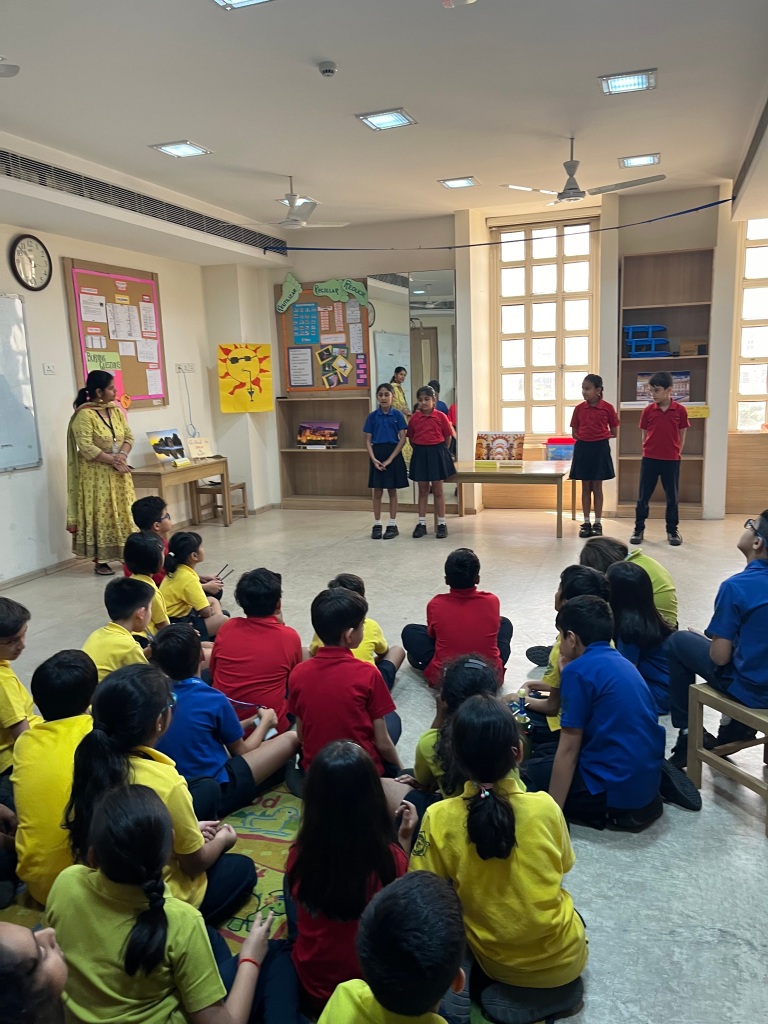


Hindi:
Students enhanced their storywriting skills with varied learning engagements. They also attempted a spell bee task. They completed different types of stories by filling in suitable words. They also created stories referring to a checklist for writing tasks.
Hindi – Ab initio –
Students revisited adjectives by using them to create meaningful sentences. They counted objects and wrote number names (गिनती) to expand their vocabulary and language skills. They also read a story (कौआ और हंस) to enhance their reading skills and comprehension.
Art:
Students inquired about the pressure control method in shading and created different shade variations from dark to light. They experimented with shading pencils to understand the techniques. They practiced varying pressure on the pencil to achieve different tones and focused on transitioning smoothly from dark to light shades. They eagerly applied what they learned, creating artwork that showcased their newfound understanding of shading techniques.
ICT:
Students were introduced to the digital storytelling app ‘Storyboard That’, fostering communication skills and creativity. They commenced their storyboards by incorporating elements such as scenes, characters, speech bubbles, and props, thus enhancing their digital literacy and collaborative skills.
PHE:
Students engaged in football practice where they diligently honed their skills in kicking and passing. They improved their body-mind coordination and balance, focusing on refining their kicking technique.
Dance:
Students delved into the art of choreography, focusing on understanding fundamental elements like body movements and energy dynamics. With playful exploration, students gained a deeper understanding of expressing themselves through dance, mastering these essential elements with grace and creativity.
Music:
During music lessons, students enjoyed singing songs of different genres. This engagement enhanced their understanding of genres and developed their singing skills. Additionally, they were introduced to musical dynamics, learning the crescendo and decrescendo, and exploring ways to apply them in their singing.
SEL
During their social-emotional lessons, students embarked on a transformative experience sparked by the heartfelt tale of ‘The Invisible Boy.’ They learned valuable lessons about empathy, responsibility, and the impact of kindness. Brian’s journey resonated with feelings of being unseen, prompting reflections on their influence on others. Discussions centred around making responsible choices, supporting peers, and fostering empathy. It created a friendly atmosphere where everyone felt included, breaking down barriers and fostering a caring community. By embracing acts of kindness, students discovered the ripple effect of positivity, realizing the profound joy of making a difference.
Library:
Students are eagerly awaiting the Crowned Owl Ceremony Day. They have kept a record of stories they have read using their reading logs. The final count of books will determine the students who will be honoured during the Crowned Owl Ceremony.
Book Owls – Reading Programme
Bring Your Pillow Day and pair reading: Students read in pairs for a supportive literacy session. They selected texts and read aloud to enhance fluency and pronunciation. They enjoyed an aesthetic, relaxed environment, fostering collaboration and a love for reading in a comfortable, scenic setting.
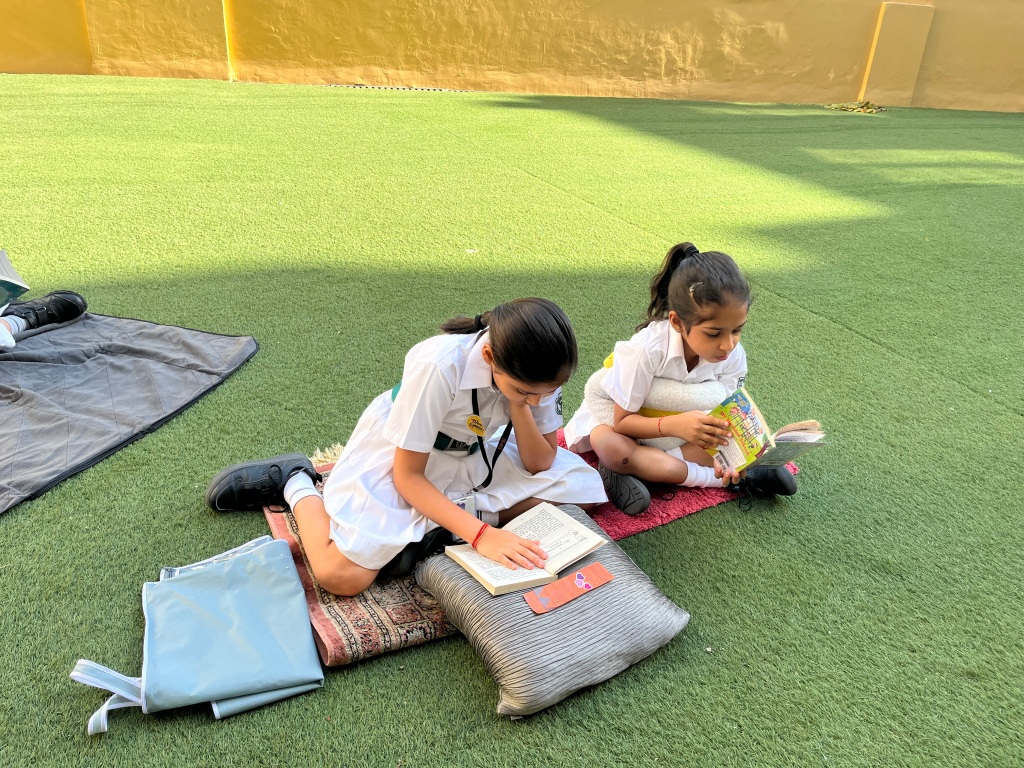


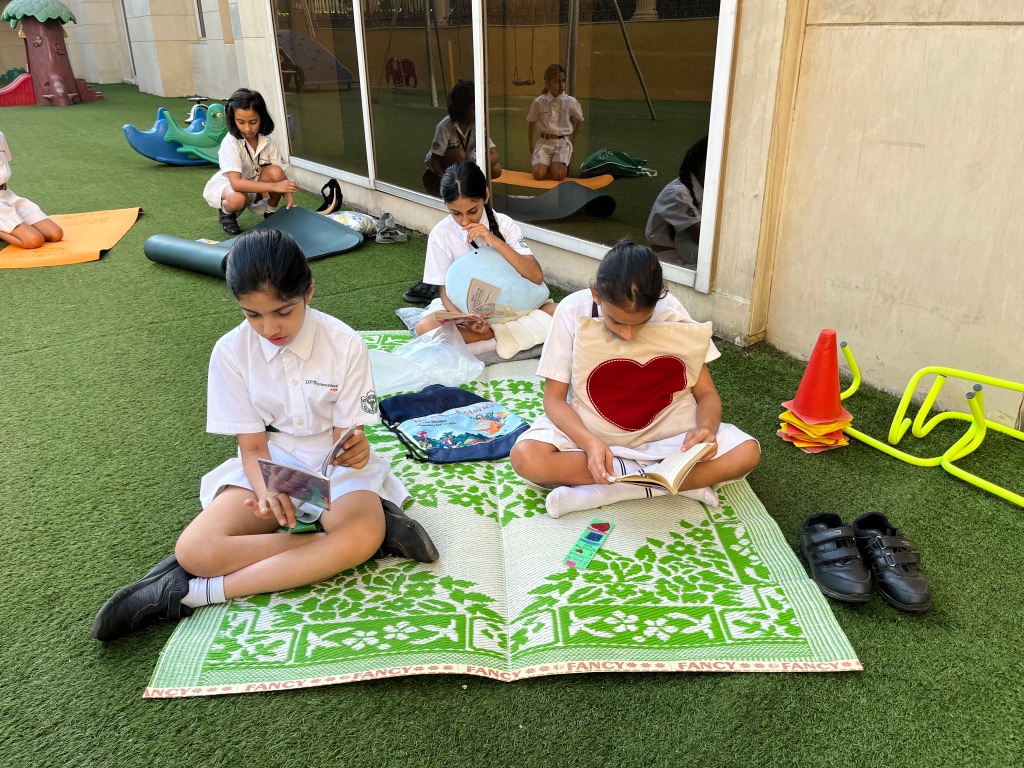
Scrabble qualification rounds– Students played a rapid version of Scrabble to qualify for the upcoming Scrabble tournament
Grade 3 Blog
April 8th – April 19th, 2024
UOI: (Rishika Sharma– Grade 3A)
Students began their inquiry of the sense of taste with an activity where they were blindfolded and took turns to taste and identify different things. They also inquired about the structure of the tongue, its parts, and their function. They explored the importance of sense of taste and how it helps us understand our environment. They researched in groups to understand different ways to take care of their tongue. They also attempted a formative assessment to share their understanding.
As an extension of their learning, Grade 3 students went for a field trip to the National Science Centre. They thoroughly enjoyed exploring the interactive exhibits on sense organs, captivating displays, team quizzes, and hands-on activities, helping them understand the role of our sense organs in shaping our understanding of the world.








English: (Anika Mehra – Grade 3A)
Students read and comprehended text from the novel study. They also delved into poetry and couplets, focusing on rhyme and expression of feelings. They attempted to compose poems/songs/couplets using their sensory experiences and imagery. Words containing the ‘v’ and ‘z’ sounds were also explored by the students.
Math:
Students furthered their understanding of measurement by practicing conversions between various units of length and weight. Going further, students enhanced their problem-solving abilities by solving word problems based on real-world scenarios.
French:
Students began the class by sharing their research findings about animals, their habitats, and eating habits. They worked with their clock partners to research different types of weather. They compared the seasons in France and India. They performed a role play in groups to demonstrate their understanding of the topic.
Reference link: https://wordwall.net/resource/54599265/french/s3-exam-22-23-weather
https://www.liveworksheets.com/w/fr/francais-langue-etrangere-fle/244277
Spanish:
Students listened to a Spanish song about commonly used verbs in daily routines. They recorded them in their journals and framed sentences choosing appropriate verbs. They began their preparation for Spanish Language Day. Students learned about monuments of cultural significance in Spain. They learned interesting facts about each place and framed sentences in Spanish.
Hindi:
Students were introduced to ‘कहानी लेखन ‘. They read different types of stories and used their critical thinking skills to make predictions about the plot and characters. Students practiced paragraph writing and enhanced their reading and speaking skills with loud reading practice. They also attempted the spell bee challenge.
Hindi – Ab initio –
Students read the story “बकरी का बच्चा और भेड़िया” (The Goat’s Kid and the Wolf), to enhance their listening and comprehension skills. They applied their critical thinking skills to comprehend the pictures and sequence the story. They also reinforced their knowledge of opposites by constructing sentences using pairs of opposite words.
Art:
Students explored one-point perspective through landscapes. They skilfully depicted how all elements in the landscape seemed to coalesce at a single vanishing point, creating a sense of depth and dimension. They gained an understanding of artistic techniques and also refined their skills with observation and execution.
ICT:
Students understood the significance of regular breaks to safeguard their physical health from prolonged screen exposure. They also gained insight into the digital storytelling app ‘Storyboard That’.
PHE:
Students practiced freestyle swimming with assistance, aiming to improve their technique and stamina for short-distance swimming. At the tennis court, students honed their forehand hitting skills and participated in rallies with their partners, refining their coordination and strategy.
Dance:
Students delved into the art of choreography, focusing on understanding fundamental elements like body movements and energy dynamics. They gained a deeper understanding of expressing themselves through dance, mastering these essential elements with grace and creativity.
Music:
Students actively listened to various songs, allowing them to experience the diverse emotions conveyed by the songs. They also learned new songs, which not only improved their singing skills but also enabled them to deepen their connection with the emotional essence of the music through both listening and singing.
Library:
The excitement among students for the upcoming Scrabble competition is palpable, as they eagerly wait to showcase their skills. During library lessons and reading time, they enriched their vocabulary by immersing themselves in books, magazines, newspapers, and dictionaries. The first round of the Scrabble competition was recently played during library lessons, adding an element of friendly competition and strategic thinking to their academic routine. The selected finalists from this round will compete in the final matches in the upcoming weeks.
Book Owls- Reading Programme
Students played a rapid version of Scrabble to qualify for the upcoming Scrabble tournament.
Book Owl mentors hosted ‘Book Speed Reading,’ which allowed students to explore various genres. With one to two minutes to discover each book, students moved to new tables to immerse themselves in different themes. They marked a reading rubric and reflected on their reading capabilities. These activities enabled them to create SMART reading goals for themselves that are measurable and attainable. Creating time-bound and relevant goals helped students take ownership of their reading journey.
Earth Day celebration
Earth Day is a vital reminder of our responsibility to protect the planet. Celebrating it as a family fosters a sense of unity and instils eco-conscious values, ensuring a sustainable future for generations to come. Kindly click on the link below to indulge in interesting activities related to Earth Day-
https://www.today.com/life/holidays/earth-day-activities-rcna70983
Grade 3 blog
UOI: (Senate member – Daksh Singh and Aaradhya Kothiyal)
Students learned about the sense of smell by participating in an activity where they took turns smelling the contents of containers without opening them. They also inquired about the structure of the nose, its parts, and function. They explored the importance of sense of smell and how it helps us understand our environment. Students researched in groups to understand different ways to take care of their noses. They also attempted a formative assessment to share their understanding of the sense of hearing and sight.






English: (Aaradhya Kothiyal and Asmara Chopra)
Students were introduced to the grammar concepts of onomatopoeia and contractions. They applied their knowledge of onomatopoeia to create comic strips. They identified contractions in select chapters from the novel “The Adventures of Huckleberry Finn” which was followed by writing paragraphs incorporating contractions.
Students read and comprehended text from the novel study.







Math:
Students attempted a summative assessment on fractions. They began their exploration of the concept of measurement and shared their prior understanding with the ‘I see, I think, I wonder’ strategy. The ‘Flying self-made paper planes’ activity was exciting and helped them understand the concept of measuring distance in meters. Students measured various items using appropriate tools and recorded their observations. They recapitulated the standard units of measurement and learned the conversion of units for measuring length.











French:
Grade 3 students had an exciting week celebrating French Language Day on March 20 and World Water Day on March 22. They explored water scarcity issues worldwide and discussed case studies from different countries. They also enjoyed a French storytelling session and shared their reflections using French vocabulary.
Spanish:
Students learned about the essential verb ‘hay’ that translates to ‘there is’ and ‘there are’. They attempted to phrase sentences using the verb ’hay’ and the vocabulary acquired during prior learning sessions. They also explored the vocabulary related to places in a neighborhood. Students also played an online game based on the verb ‘hay’ and used the verb to describe their classroom, house, or city. Students learned vocabulary related to their hobbies and shared it with their peers.
Hindi:
Students were introduced to ‘अनुच्छेद लेखन’ . They read different types of paragraphs and compared them. They also created a checklist for writing a paragraph and wrote a short paragraph based on a picture prompt. They used the checklist to review the first draft of their paragraph. They also attempted a spell bee task.
Hindi ab-initio
During their Hindi ab initio class, students revisited ‘आधे अक्षर वाले शब्द’ and created sentences using them. To assess their prior knowledge of counting, students recited a poem titled ‘एक बड़े राजा की बेटी’ and identified the numbers in the poem.
Art:
Students delved into the concept of one-point perspective in landscape art. They portrayed perspective within natural elements using paints and color pencils according to their preferences. They illustrated the illusion of depth and distance in their artwork, employing creativity in colors and techniques to evoke a sense of spatiality in nature. The exploration enhanced their comprehension of perspective and its significance in capturing natural landscapes.
ICT:
In their Scratch project, students displayed notable skill development. They used events and control blocks, showcasing a keen understanding of coding concepts. Through experimentation and problem-solving, they demonstrated proficiency in navigating Scratch’s interface and implementation of logical sequences in their projects. This experience enhanced their ICT skills and fostered critical thinking and creativity.
PHE:
Students practiced freestyle swimming with assistance, aiming to improve their technique and stamina for short-distance swimming. Meanwhile, on the tennis court, students honed their forehand hitting skills and participated in rallies with their partners, refining their coordination and strategy. These activities provided valuable opportunities for students to develop their body strength and eye-hand coordination.
Dance:
Students delved into the art of choreography, focusing on understanding fundamental elements like body movements and energy dynamics. Through playful exploration, students gained a deeper understanding of expressing themselves through dance, mastering these essential elements with grace and creativity.
Music:
During music lessons, students played the keyboard using their understanding of keys. They learned to play a major and a minor scale using the correct scale playing technique in an octave. This engagement enhanced listening skills (intonation) and pitch accuracy. Students were introduced to chord tones (note names) of C major and A minor. They also learned how to find a relative minor of any major chord.
Library:
The theme for April ‘Biographies and Autobiographies’ was introduced to students. Through an anchor chart, they inquired into the essential elements that defined biographies. The library buzzed with the energy of engaged readers, each absorbed in the narratives that brought historical and inspirational figures to life. The ‘Book Owl’ program fostered literary exploration and instilled a deeper appreciation for the resilience and accomplishments of individuals who shaped our world.
SEL:
During their Social-emotional lessons, students listened to the story, ‘Simon’s Hook’. They grasped the importance of self-regulation and positive thinking. They concluded that it is important to practice positive affirmations and respond to unsettling experiences confidently.
Reading programme
Reading Day Trip-A reading day trip to Aravalli Biodiversity Park gave the students an opportunity to enjoy reading amongst nature and engage in games and discussions. Parents joined students at the venue and enjoyed their time together.
Reading check in-
Students used the traffic light strategy to share their passion points and pitfalls during their reading journey.
Grade 3 blog
March 4 – March 17, 2024
UOI: (Meera Barar – Senate Grade 3B)
Delving deeper into the functions of sense organs, students learned about the structure of the eye and its parts. They labelled the parts and their functions. They researched in groups to understand different ways to take care of their eyes.
Students made a list of sounds that they enjoyed listening to and sounds that they found unpleasant. They explored the sense organ – the ear and participated in a chalk-talk activity to answer questions related to the anatomy of hearing, the importance of our sense of hearing, and how hearing helps us understand our environment. Students learned about the structure of the ear by observing diagrams and 3-D models of the human ear.

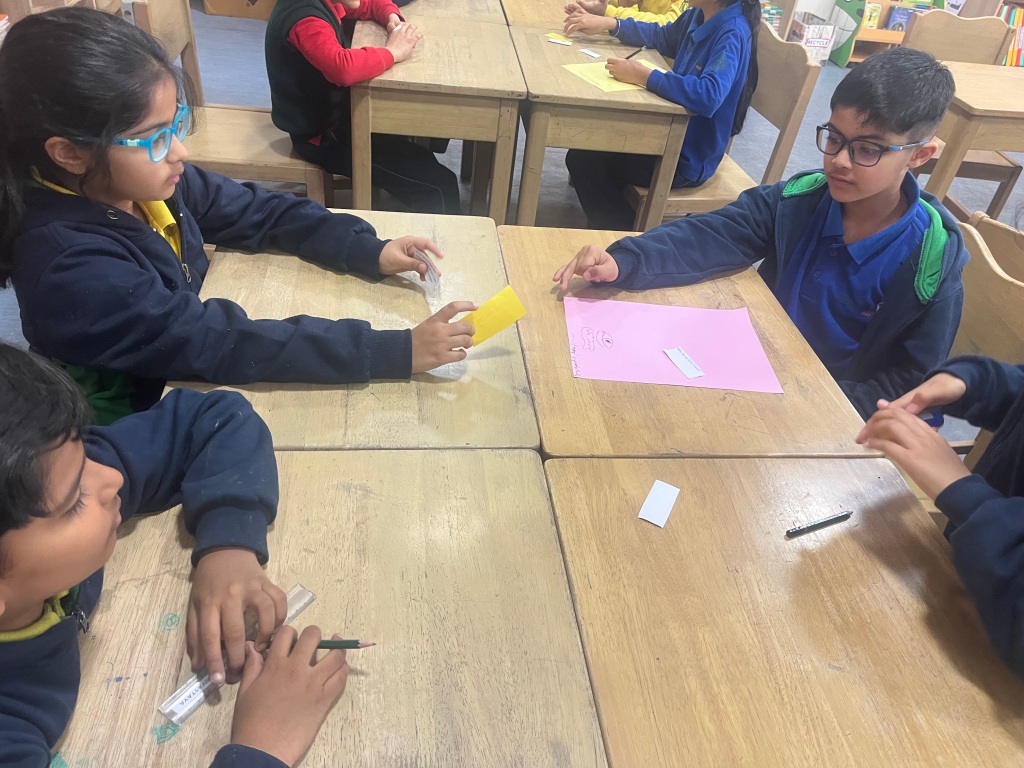




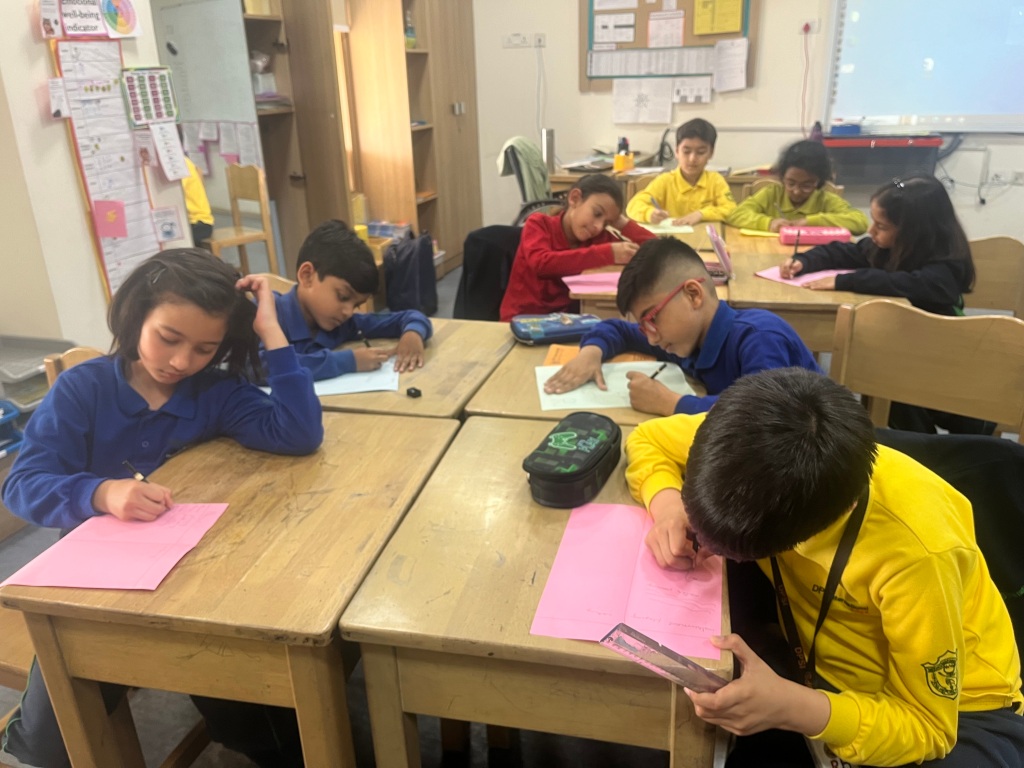



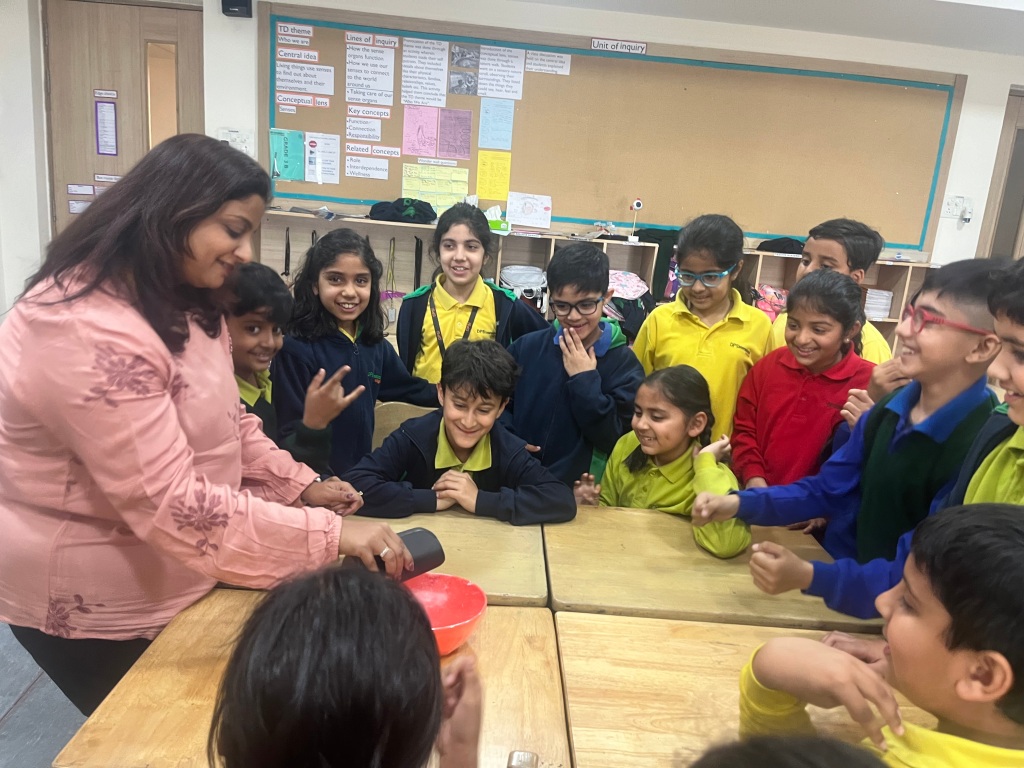
English: (Meera Barar and Anaahat Chowhan – Grade 3B)
Provocation to grammar concepts of interjections was done with role plays by teachers and students. This was followed by reinforcement with drill sheets. In the literary realm, students read, comprehended, and analysed chapters 23, 24, 27, and 28 of the novel – The Adventures of Huckleberry Finn.
They learned the nuances of spelling with the ‘ai’ and ‘ay’ letter combinations, alongside words with ‘th’ and ‘air’ sounds.
Math:
Students were introduced to the concept of equivalent fractions wherein they understood how different-looking fractions could have the same value. Students then practiced word problems based on fractions.




French:
Students took a virtual tour of a marketplace in France and explored different fruits and their names in French. They demonstrated their understanding by making phrases in French using the verbs aimer, avoir like-J’aime manger la mangue(I like to eat mango), j’ai une pomme(I have an apple). Furthermore, students played the game of Bamboozle and word wall for a better understanding of the topic.
Reference : https://wordwall.net/resource/4098340/les-fruits
Spanish:
Students participated in an online game to recapitulate vocabulary related to different parts of a house. They were introduced to the verb gustar which is used to express likes and dislikes. Students noted the rules and structures governing the use of this verb and wrote 2 sentences each to express their likes and dislikes.
Hindi:
Students were taught about ‘संयुक्त व्यंजन’ and ‘द्वित्व व्यंजन’. They also took part in group activities to understand the difference between ‘संयुक्त व्यंजन’ and ‘द्वित्व व्यंजन’. They also attempted a spell bee task.
Hindi ab-initio
Students were introduced to ‘आधे अक्षर वाले शब्द’ through an interactive PowerPoint presentation. They learned how to pronounce these words correctly and practiced writing them. Students were also assessed for their reading and comprehension skills.
ICT:
Students were introduced to ‘Scratch’, the block-based coding platform, an excellent tool for them to learn coding in a fun and interactive way. They learned to use motion and appearance blocks to create animations and games. Students went through the step-by-step process of building these projects, starting from creating simple sprites to mastering more advanced skills. Alongside coding, students also developed computational thinking and problem-solving skills essential for navigating the digital world effectively.
PHE:
Students learned various cricket shots and practiced ball throwing. They thoroughly enjoyed learning the nuances of the game.
Dance:
Students delved into the art of choreography, focusing on understanding fundamental elements like body movements and energy dynamics.
Music:
During music lessons, students were engaged in reviewing the note values which are fundamental in understanding notation. They were then introduced to keyboard playing. They have understood the finger numbers, and hand position and have learned to identify the white keys and name them. Students also attempted to play a C Major Scale, both LH and RH using the correct finger numbers for the notes C-D-E-F-G-A-B-C (Octave) on a keyboard.
Library:
A new genre “Biographies and autobiographies” was introduced to students. They enthusiastically delved into the enchanting realm of biography, gaining a profound understanding of their key features. Through an anchor chart, they inquired into the essential elements that defined biographies. The library buzzed with the energy of engaged readers, each absorbed in the narratives that brought historical and inspirational figures to life. The ‘Book Owl’ program, with its focus on Biography, not only fostered literary exploration but also instilled a deeper appreciation for the resilience and accomplishments of individuals who shaped our world.
SEL:
Continuing from the previous lesson wherein they listened to a story on empathy and inclusion, ‘The Colourful Garden’, students progressed by delving deeper into the significance and individuality of each flower within the garden. They explored how the story intertwined with their personal experiences and the communities they belong to, establishing meaningful connections. Demonstrating their appreciation for diversity, students meticulously arranged the flowers in the diversity garden, acknowledging the unique contribution of each blossom to the overarching tapestry of inclusivity. Engaging in a word search activity, they identified terms that fostered positive thinking, enriching their understanding of empathy and acceptance. Through a dynamic class discussion, students exhibited their reflective abilities by distinctly summarizing the lessons in previous sessions.
Reading program:
During the Book Owls sessions, students used a rubric to assess their reading skills. This self-assessment process enabled them to reflect deeply on their reading abilities. Students engaged in discussions in pairs about their favourite books while sharing compelling narratives and insights. They used reading response cards to offer a perspective about their ability to make text-to-text and text to world connections.











Grade 3 Blog
February 19th – March 1st, 2024
UOI: (Rishika Sharma– Grade 3A)
Students delved deeper into the third line of inquiry with a transdisciplinary session by Ms. Shreerisha and Ms. Gyateu (performing arts) to understand the impact of migration on culture and local art forms. A guest speaker session by the Primary School Principal, Ms Kamal Shah, gave them further clarity about the topic. Some students also shared their migration journey which helped their peers to make relevant connections. Students displayed their understanding of the unit by attempting an open-ended task as part of their summative assessment.
Provocation to the new unit ‘Senses’ was done through an activity wherein students made a self-portrait and were able to make connections with the Transdisciplinary theme- ‘Who we are’. Students went for a sensory nature stroll where they documented their observations of what they could see, hear, feel, and smell. The central idea was unpacked and students shared their wonderings by creating thick-and-thin questions.


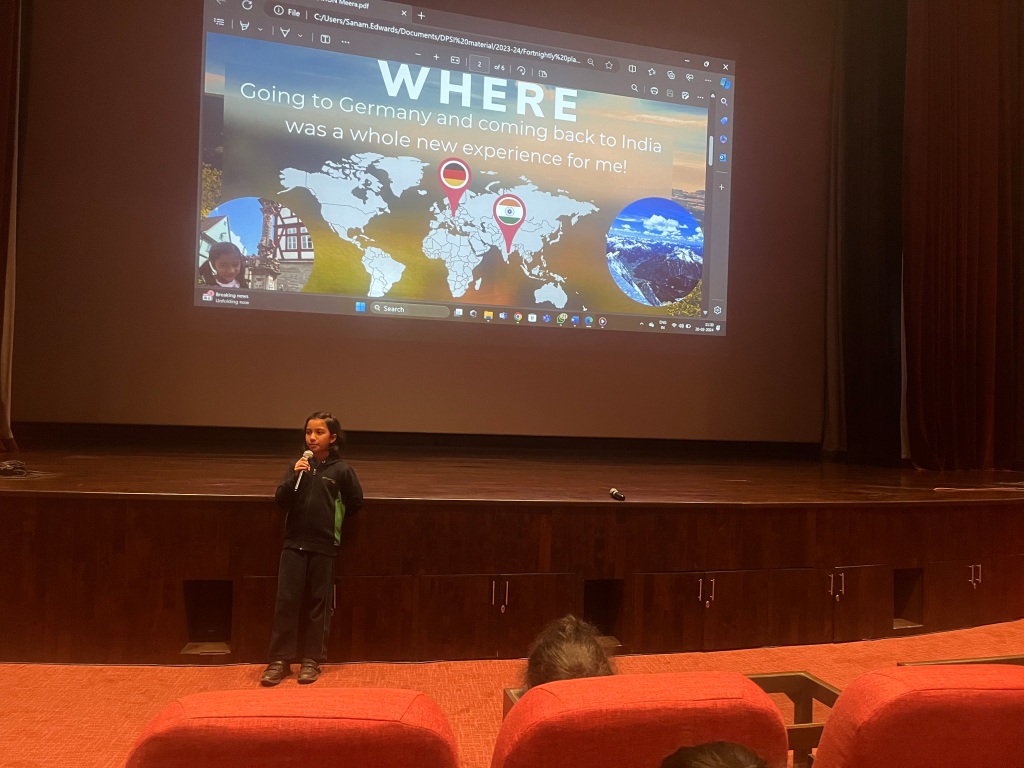
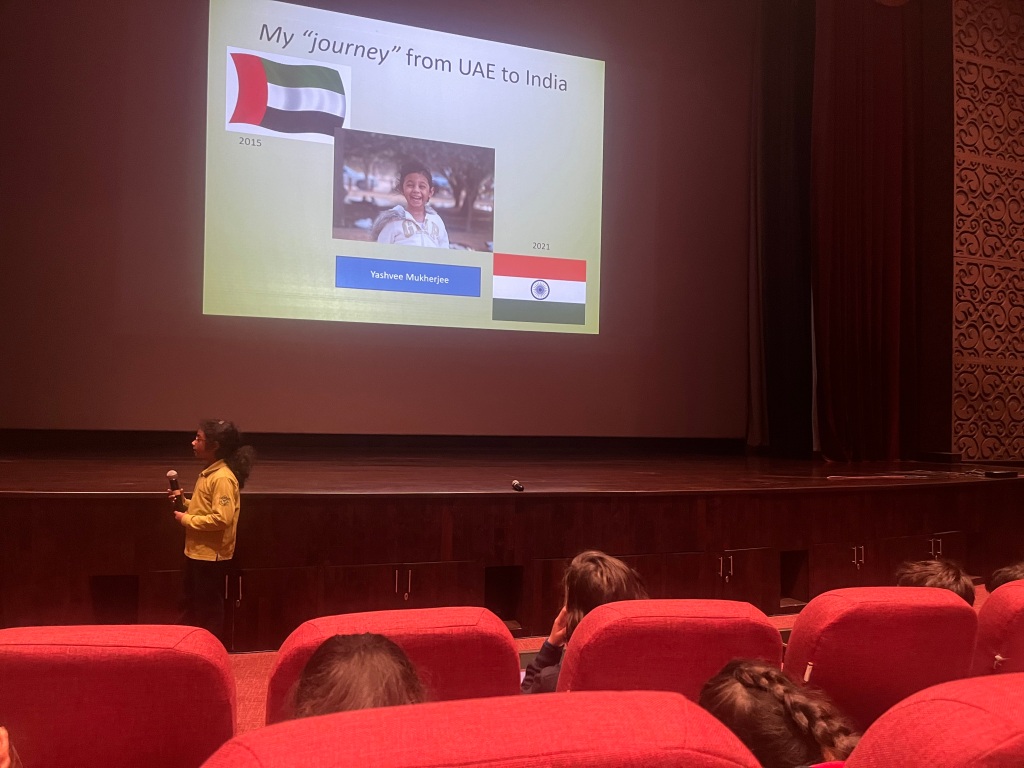











English: (Anika Mehra – Grade 3A)
Students were tuned into the concept of adverbs through the ‘Simon Says’ game. They worked in groups to inquire about different types of adverbs – of time, manner, place, and frequency. Students used a variety of resources such as iPads, English grammar books and fact sheets to conduct their research. Students read, comprehended, and summarized chapters 21 and 22 of the novel ‘The Adventures of Huckleberry Finn.’ They were divided into two groups. First group made text-to-text connection by comparing the novel “Huckleberry Finn” with the novel they were currently reading during their reading program. The second group engaged in a text-to-self connection by drawing comparison between the text and their real life experiences.
Math:
Students were introduced to fractions using manipulatives like Jodo cubes and paper cut-outs. They learned to represent fractions on a number line. Students also learned about like/unlike fractions and their comparison. They also attempted drill sheets for reinforcement.
French:
Students shared their prior knowledge of numbers. They also explored maps of Francophone countries, their capitals, and famous cuisine. They learned how to tell time in French. Students paired up using clock partner strategy and answered questions about time. Such as – à quelle heure tu as le cours de français?(At what time do you have French class?), à quelle heure tu manges le déjeuner? They were also introduced to expressions such as Il est midi (It’s noon), Il est minuit (It’s midnight).
Reference link: https://wordwall.net/resource/9671948/french/quelle-heure-est-il
Spanish:
Students played a bingo game and online games to strengthen their understanding of adjectives. As an exit ticket, students wrote classroom objects. They also read a passage to hone their reading skills. Students were familiarised with the vocabulary for interiors of a home with a labelled illustration.
Hindi:
Students reviewed the checklist for picture composition and practiced ‘चित्र वर्णन’. They actively honed their reading and speaking abilities by engaging in reading practice. They were also introduced to ‘संयुक्त वयंजन’ with real-life examples.
Hindi – Ab initio
Students comprehended pictures and rearranged jumbled words to form grammatically accurate sentences. This exercise not only enhanced their reading and comprehension skills but also encouraged the usage of singular and plural words to construct meaningful sentences. By actively participating in this activity, students fortified their language skills and developed a deeper understanding of sentence structure and grammar.


Art:
Students went on a nature walk to discover the various colours found in nature. During the walk, they collected different objects from the environment. They practiced drawing landscapes by observing a variety of landscape paintings by David Hockney.
ICT:
Students were engaged in creating a video using the Canva app, integrating various elements such as backgrounds, text, images, animations, and audio. Through this task, they enhanced their creativity in integrating diverse media elements and proficiency in multimedia composition.
PHE:
Students learned the baton exchange technique and relay race strategy. This dynamic session focused on honing their coordination, teamwork, and speed. They practiced precise baton passes, emphasizing seamless transitions to optimize relay race performance. Through collaborative efforts and strategic planning, they developed a deeper understanding of relay dynamics, fostering both individual skills and collective synergy in the realm of track and field.
Dance:
Students warmed up before crafting unique dance pieces in four groups, each exploring different expressions. They also learned about artist migration. They gained a brief insight into the life of few artists who migrated for better opportunities and created lasting impact on the culture of a place.
Music:
During music lessons, students used their understanding of dynamics and expression while listening to music, and applying it to their singing. They were also engaged in application and rhythm practices along with play-along tracks using classroom instruments.



Resources – https://youtu.be/LxWPvSp1_qA?feature=shared
Library:
The school book fair is an exhilarating time of year for students. They explored various types of books, new authors, and different genres, broadening their horizons in the process. With books ranging from fiction and fantasy to science fiction and non-fiction, they delved into topics spanning history, science, math, and even the future. Among the array of options, they found a variety of books to choose from and enjoyed discovering those that piqued their interest. Moreover, they enjoyed the lively atmosphere of the book fair, relishing the chance to connect with fellow book lovers. In the end, they experienced a sense of accomplishment after finding the perfect book for themselves.
SEL:
During their Social-Emotional session, students embarked on a journey to explore the intricacies of prejudice and empathy. By engaging with the story of ‘The Colourful Garden’, they immersed themselves in understanding, inclusiveness, and collaboration. The narrative unfolded as a powerful tool to initiate discussions on understanding prejudice, fostering empathy, and cultivating collaborative problem-solving skills
As they listened attentively, they witnessed Rosie’s arrival and the initial frostiness of the other flowers. Through Rosie’s exclusion, they understood the garden’s loss of charm and the butterfly’s wisdom about diversity.
Engaged in reflective dialogue, students pondered over the treatment of Rosie and the significance of embracing differences. They explored the connections between the situation in the story and their own lives, recognizing the importance of acceptance. For the follow-up activity, students were encouraged to make their flower characters. Encouraged by the story, students were inspired to explore their imagination, cultivating a garden where every individual bloom reflected empathy, understanding, and collaboration in its way.
Book Owls- Reading Programme
Mentors selected excerpts from various books, choosing passages with suspenseful ending. The intention was to spark curiosity among the students and encourage them to read books to discover what happens next. Game Day saw students delve into the world of Scrabble.
Grade 3 blog
February 5 – February 16, 2024
UOI: (Daksh Singh – Senate Grade 3C)
Delving deeper into the second line of inquiry, students examined historical migrations, like the India-Pakistan migration, the California Gold Rush, and that due to COVID-19. They critically examined and reflected on the causes and effects of these significant movements, thereby enriching their understanding of migration in history. Ms. Tania Smith, our grade 5 form tutor shared insights into her migration journey from the United Kingdom to India. Students reflected on the session using the 3-2-1 strategy. Engaging in a collaborative task, students inquired into the third line of inquiry by examining case studies on migration. This allowed them to empathize with migrants and understand their adaptation processes in the host country. Students proceeded to create an empathy map for a migrant, further enhancing their understanding.


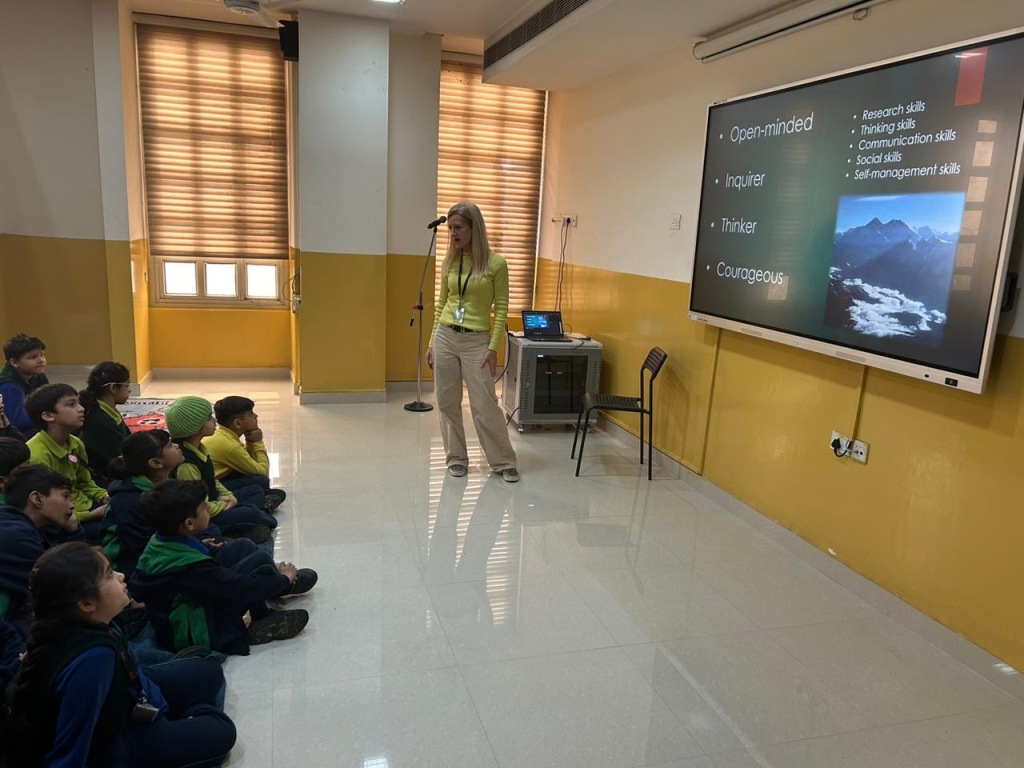
English: (Daksh Singh – Senate Grade 3C)
Students worked in groups to inquire about different types of prepositions like cause, purpose, comparison, and manner with various activities, and drill sheets were attempted for reinforcement. In the literary realm, students read, comprehended, and summarized chapters 17 and 18 of the novel ‘Adventures of Huckleberry Finn. Students were divided into two groups. They generated questions based on the chapters and exchanged them with their partners for answers. They also showed their understanding of prepositions by identifying prepositions in the chapters. Students also attempted a spell bee task.


Math:
Students understood the usefulness of divisibility rules for testing whether a number is a multiple of another or not. Divisibility rules of 2, 3, 5, and 10 were done in the class. Students grasped the inverse relationship between multiplication and division along with fact families. They solved simple division equations using the long division method in their journals. They applied their understanding of division to solve word problems based on real-life situations.
French:
Students played the game Bamboozle to demonstrate their understanding of different body parts. Furthermore, students revised the numbers up to 60. They played number games using translanguaging. Students discussed the reasons for migration to France. They also learned vocabulary related to migration in the targeted language.
Reference link: https://wordwall.net/resource/7339692/french-numbers-1-to-60
Spanish:
Students familiarized themselves with vocabulary related to birthday celebrations. They noted the essential words in their journals. Students used their creative thinking skills to design birthday greetings while incorporating their acquired vocabulary and phrases. They also played Bingo game based on interrogatives. Students watched a jingle based on interrogative words in Spanish while enunciating each word to practice their pronunciation skills. Finally, students noted down the interrogative words in their journals along with their English meanings.
Hindi:
Students practiced informal letter writing. During their Hindi classes, students dedicated their time to reviewing the drafts of their informal letters. They actively honed their reading and speaking abilities by engaging in reading practice. They also attempted a spell bee task.
Hindi ab-initio
During their Hindi classes, students learned about अनुनासिक (चन्द्र बिंदु) and expanded their vocabulary by writing related words. By listening to words, students distinguished between words with the अं and अँ sounds. They created sentences using nouns(संज्ञा) and verbs(क्रिया) based on pictures and learned about singular(एकवचन) and plural(बहुवचन) forms. They practiced writing words and sentences in both singular and plural forms.
Art:
Students engaged in an activity to enhance their comprehension of colour theory, focusing on tint and shades while practicing colour mixing techniques. Through this activity, students not only enhanced their understanding of colour theory but also cultivated their critical thinking skills and self-management abilities.
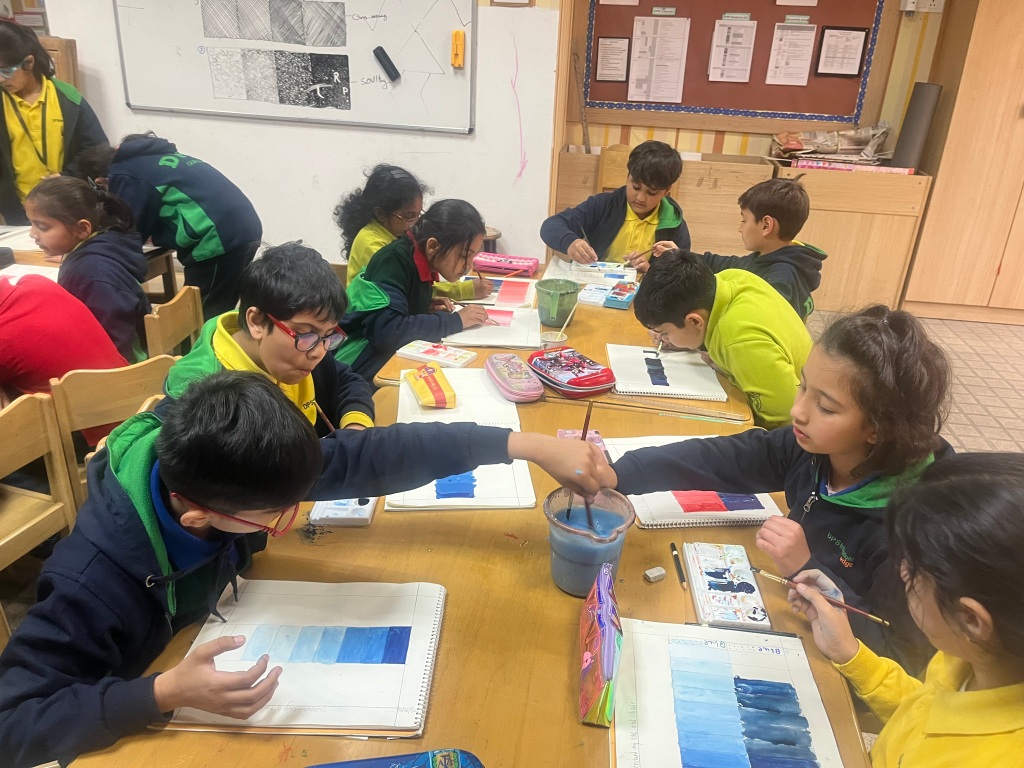




ICT:
Safer Internet Day was observed between February 5-9, 2024 to reinforce the concept of Internet safety. Students explored the pros and cons of the internet and highlighted safe and responsible online behavior. They also learned to behave in a positive, safe, and ethical manner when using age-appropriate apps and websites. They strengthened their understanding of the topic by attempting a quiz.Furthermore, they used different elements of Canva posters like elements, text, and photos, animation to design digital posters on wildlife conservation.
Dance:
This week students learnt about correct gestures and movements to convey emotions. Students also learned about migration in dance as an integration to their current Unit under the TD theme ‘Where we are in place and time.’
Music:
Understanding dynamics in music is crucial to conveying emotion, intensity, and expression. During music lessons, students learned the different dynamics commonly used in music. Practicing these dynamics in different songs helped students develop a keen sense of control over their voice, contributing to their overall musicality and interpretational skills of the songs.
Library:
Students were introduced to an engaging vocabulary-building activity with a game of Scrabble. This timeless game not only entertains but also serves as a tool for enhancing thinking skills while expanding vocabulary. Throughout the session, they were meticulously guided through the rules and regulations of Scrabble, thereby equipping them with the knowledge needed to navigate the game effectively.
As the lesson progressed, excitement bubbled as students eagerly formed new words, collaborating within groups to maximize their scores and use of strategy. Beyond the mere mechanics of the game, Scrabble fostered critical thinking, creativity, and linguistic fluency, empowering students to express themselves with confidence and precision. With each tile, students embarked on a journey of discovery, uncovering the boundless potential of language.
SEL:
In their journey of understanding bullying, students delved into the narrative of “The Juicebox Bully”. This story served as a catalyst for fostering compassion, solidarity, and collective action within the school community. It enabled them to explore the depths of social awareness, empathy, and the profound impact of one’s actions on others. Together they comprehended the nuanced role of bystanders in halting such behaviours and unearthed positive strategies for conflict resolution and building authentic connections with peers. Class discussions and reflections allowed them to unearth the significance of standing up for others and fostering a culture of empathy and kindness. They discerned the subtle nuances distinguishing bullying from conflicts or disagreements, delving into the emotional, psychological, and academic repercussions faced by victims. Following their exploration of the aforementioned narrative and the understanding gained about bullying, students engaged in a reflective and interactive activity: ‘See-Think-Wonder’ visible thinking routine.


January 23rd – February 2nd, 2023
UOI: (Meera Brar – Senate Grade 3B)
Delving deeper into the first line of inquiry, students researched the positive and negative impacts of migration and presented their findings collaboratively. They were introduced to Sustainable Development Goal 10 (Reduced Inequalities) and gained an understanding of how migration can help in overcoming inequalities in pursuit of an improved lifestyle.
In a group task, students selected a young immigrant, explored their personal story, and subsequently presented findings through a role-play emphasizing the impact of migration on the individual.
English: (Meera Brar – Senate Grade 3B)
Students were also introduced to the format and purposes of informal letter writing. They were given the choice of writing informal letters on any of the scenarios. Students also attempted a spell bee task.
Math:
Students learned different strategies for dividing numbers such as equal grouping, repeated subtraction, and division using the number line and a number chart. Regular practice helped students gain confidence in dividing numbers and they attempted a formative assessment on the same.
French:
Students started the week by revising the things they learned in previous classes. Furthermore, they enjoyed, sang, and danced along to a French song- <<Jean petit qui danse>>. Later they played a game in the class << Touch right body part>>. They inquired about the different names of the body parts and designed a well-labelled diagram in their journal. Using a grouping strategy they did an activity asking questions qui est tes yeux(where are your eyes?) and did a speaking activity with their group. In the subsequent week, they played a game named Bamboozle to demonstrate their understanding of the topic.
Spanish:
Students learned essential vocabulary related to their family. They watched a video that explained how we address our family members, and they noted down the information in their journals. Additionally, they participated in a small activity that involved answering riddles to identify different family members. During the next two classes, the students were taught how to identify the objects that form the basis of the classroom environment. They not only learned the names of the objects commonly found in a classroom but also improved their understanding of how to use indefinite articles correctly, considering the gender and number of the nouns.
Hindi:
Students were introduced to and practiced informal letter writing. During their Hindi classes, students dedicated their time to reviewing the different drafts for writing letter. They actively honed their reading and speaking abilities by engaging in reading practice. They were also attempted spelling challenge that was followed by writing practice.
Hindi – Ab initio –
During their Hindi classes students engaged in an interactive activity where they analyzed a picture and created descriptive sentences using proper structure, By learning अनुस्वार (अं मात्रा) words, students understood their meaning and enhanced their vocabulary by writing down related words. They also formed meaningful sentences.
Art:
During their art lesson, students were introduced to colour theory. They had a wonderful time learning how to create tints and shades. They were taught the art of mixing colours and creating beautiful tints of white and bold shades of black. They also had the opportunity to develop their painting skills by getting hands-on experience with brushes.
ICT:
Students designed digital posters using Canva on wildlife conservation. They used different elements of Canva like background, text, and photos to create the posters. Students researched how digital conservation technologies and services can drive wildlife conservation.


PHE:
Students engaged in vigorous athletic practice during their Physical Education lessons, showcasing a commitment to physical fitness and skill development. The sessions incorporated various sports activities, fostering teamwork, discipline, and overall well-being among the students.



Dance:
Students learned about correct gestures and movements to convey emotions. Students also learnt about Migration in dance as an integration to their current unit namely Where we are in place and time.



Music:
During music lessons, students immersed themselves in the rhythmic pulse, with lovely enthusiasm, using an untuned percussion instrument (tambourine) in the classroom, and playing along with the music. This exercise showed their creative rhythmic ability.
They eagerly embraced the introduction of new songs which further boosted their musical exploration while they learned to appreciate diverse styles and genres.
Library:
In the enchanting world of literature, students eagerly embraced the introduction to the new reading program, “Book Owls.” Excitement filled the air as they prepared to embark on a captivating journey through the realms of imagination. Reading the book titled “The Magic Paint Brush” unfolded a tapestry of wonder, allowing them to delve into the rich world of folk tales. With each turning page, students eagerly explored the key features of these timeless stories, unlocking the secrets of cultural wisdom and the art of storytelling. “Book Owl” encourages a love for reading and promises to guide this exciting literary adventure, fostering a lifelong appreciation for the magic words can weave.”
SEL:
In social-emotional lessons, students delved into the role of effective communication in fostering meaningful relationships. They understood the importance of dialogue and attentive listening, recognizing them as vital to interpersonal relationships. They gained insights into the profound impact of empathy and understanding in nurturing relationships.
Through engaging talks, students discovered the importance of communication for making good relationships, mending conflicts, and building friendships. The ‘Kimochis Keys’ equipped students with practical tools to express emotions and thoughts, fostering a common language for navigating interpersonal interactions effectively.
In the follow-up Bucket Filling Activity, students delved into the concept of filling emotional buckets with positivity. They discussed the impact of kind words and actions that foster happiness and appreciation. Writing or drawing acts of kindness, they personalized gestures for their classmates, enhancing the culture of empathy and gratitude.
After that, students reflected on filling someone’s emotional bucket and experiencing the same joy. Through discussion, they explored the link between effective communication and positive interactions, recognizing how empathy and understanding enrich relationships.
Grade 3 Blog
January 11 – January 19, 2024
UOI
Transdisciplinary theme: Where we are in place and time
Central idea: Human migration is a response to challenges and opportunities.
Lines of Inquiry and key concepts:
- Reasons for migration (Causation)
- Migration over time (Change)
- What we can experience and learn through migration (Perspective)
Students commenced their exploration of the transdisciplinary theme with an engaging scavenger hunt. To delve into the conceptual lens of ‘migration,’ they reflected on a video illustrating wildebeest migration. Subsequently, the central idea was unveiled using the hexagon strategy.
Students shared their prior knowledge of migration using the Visual Word Association routine. They were tuned into the first line of inquiry with an interesting activity wherein they shared their perspective on whether they would like to migrate to another place and the reason for the same. This helped to ignite their interest in the unit.
Students delved into the first line of inquiry by inquiring about the different causes of migration. Subsequently, they created a Venn diagram/T-chart to showcase their understanding.
English
Students revised the parts of speech and honed their listening skills by reading chapters 13 and 14 of the novel study. They subsequently compiled lists of nouns, verbs, adjectives, and pronouns from the text.
A game of ‘Prepositions Pictionary’ was played to assess the prior knowledge of students about prepositions. Prepositions of time and place were introduced with various activities, and drill sheets were attempted for reinforcement. Students also read chapter 15 of the novel study. They identified and listed prepositions of time and place from the text.

Math
Students revisited the concepts of number system and number operations. They applied their understanding of the concepts to solve word problems based on real-life situations. Students were actively engaged in a herding game as a hands-on approach to grasping the concept of division. A discussion was held about the meaning, usage, and vocabulary related to division.


French
Students revised vocabulary related to classroom objects and colours. They learned subject pronouns and showed their understanding of pronouns during online games such as Wordwall and Blooket. They also learned about the different members of the family and their relations with each other and reinforced the French terms with the game- who is who?
Spanish
Students were introduced to numbers up to 50. They strengthened their vocabulary related to animals and revisited the concept of definite and indefinite articles. They applied their prior knowledge of gender to identify which articles would be appropriate for nouns with different genders.
Hindi
Students were welcomed to the new term with some mindfulness activities. They dedicated their time to reviewing the different topics covered in the previous term. They actively honed their reading and speaking abilities by engaging in reading practice. They also attempted a spelling challenge that was followed by writing practice.

Hindi – Ab initio
Students were engaged in a conversation about how they utilized their winter holidays. They participated in an ice-breaking activity with educational games on the word wall. They enhanced their reading skills by reading sentences with different maatra words.

Art
Students were introduced to the concept of colour theory, engaging in an activity where they drew a colour wheel and learned about colour mixing.
ICT
Students refined their coding abilities by participating in practical exercises on the code.org website, emphasizing block sequencing. They grasped the concept of algorithms and acquired the skills to debug code. These coding principles were strategically applied to solve puzzles, creating an interactive and enjoyable learning experience for the students.
PHE
Students engaged in a series of physical activities, including yoga sessions and exciting games. These activities not only promoted physical fitness but also fostered teamwork and a sense of accomplishment.
Dance
Students learned about migration through the lens of dance. They also learned a new dance routine based on the songs suggested by them.
Music
Students were introduced to percussion instruments to enhance their understanding of beats and rhythm. They comprehended the difference between tuned and untuned percussion instruments. Their learning of the two categories was evident from active participation in a virtual listening quiz.
Library
“The beauty of the world lies in the diversity of its people.”
The new year is one of the biggest celebrations worldwide. Countries around the globe enjoy various traditions to welcome new beginnings and invite prosperity. During library lessons, students inquired about the traditions and customs people follow to celebrate this special occasion. They were delighted to share their family traditions and rituals with their classmates.
An introduction to the new reading program, “Book Owl,” was given to students. They were very excited about embarking on an adventurous journey of reading. Students also shared feedback on the digital library shared during the winter break and eagerly narrated their favourite stories to their peers.

SEL
In the realm of social-emotional learning, positive self-talk emerged as an important tool for fostering emotional intelligence and overall well-being. This week, the SEL lessons, focussed on initiating a thoughtful discussion on the concept of intrapersonal communication, highlighting its profound influence on emotions and behaviour. The engaging discussion emphasized the intricate connection between positive self-talk and an individual’s overall well-being. With a subsequent exploration of fixed and growth mindsets, students were empowered to recognize and embrace the power of their thoughts.
This interactive exercise laid the foundation for deeper insights into how different types of self-talk could significantly influence our emotions and actions. As the follow-up to the discussions, students were encouraged to construct personal positive affirmations that resonated with their unique journeys. These affirmations were then shared on a Padlet, establishing a shared experience that not only strengthened the effectiveness of positive self-talk but also nurtured a classroom culture of support.
Grade 3 blog
December 4th – 15th, 2023
UOI
Students delved into understanding natural disasters such as earthquakes, floods, and droughts by exploring their causes, effects, and safety procedures. They also conducted map marking for areas prone to these disasters. They also inquired into the man-made disaster of war. They learned about the Russia-Ukraine and Hamas-Israel war and visually depicted the impact of war with sketch-noting.
Students attended a guest speaker session by Ms. Preeti Singhal (ICT teacher). She explained the meaning of digital crisis, the risks involved in internet use, and how to protect ourselves from online attacks.




English
Students learned about the degrees of comparison of adjectives with an engaging activity, where students grasped the use of the suffixes ‘-er’ and ‘-est’.
Students worked in groups to inquire about powerful adjectives. Students also attempted a spell bee task and a formative assessment on verbs and pronouns.
Math
Students explored the properties of multiplication, solving equations based on them. They learned about the vertical method of multiplying numbers and strengthened the concept with rigorous practice. They also reinforced the practical application of multiplication by solving word problems and making real-life connections.
French
Students initiated the week with an engaging activity, “What’s in my bag?” where they identified various objects in French. They listed the different objects in the classroom and made phrases using the verb “avoir” (to have). They also learned to frame questions like – “Qu’est-ce qu’il y a dans mon école?” (What’s there in my school?) using “il y a” (there is/there are). They made a list of different school places and wrote sentences- il y a une bibliotheque (There is a library.), il y a des salles de classe(There are classrooms.)
Spanish
Students learned the vocabulary related to vegetables. They used flashcards to differentiate between fruits and vegetables. They also explored subject pronouns in Spanish with a story and noted them in their journals. They appeared for a formative assessment for vocabulary related to colours, numbers, and body parts.
Hindi
Students read stories and retold them in a sequence. They worked in groups to choose a story and analyzed it to share the main idea. They also created a story using picture prompts and used a checklist to self-assess their work. They honed their communication skills by sharing the same with their peers.
Hindi – Ab initio
Students reinforced their understanding of nouns (संज्ञा) with an interesting activity. They explored the concepts of ओ मात्रा and औ मात्रा and applied their knowledge by writing words with these vowel sounds. They were assessed for their reading skills to gauge their progress in the language.


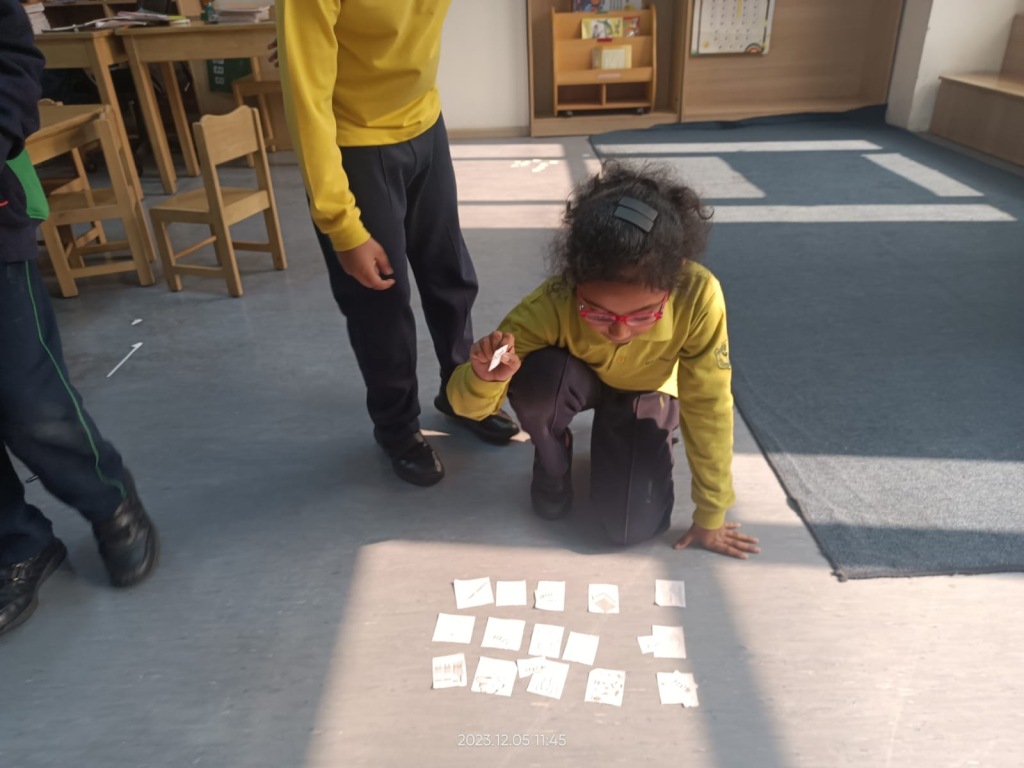


Art
During the art lesson, students focused on understanding the principles of the vanishing point and perspective lines. Students drew cubes that appeared to pop off the paper. From setting up the horizon line to adding perspective lines, they learned about depth and dimension in art, emphasizing on drawing with a light touch to create a fine drawing.
ICT
Students learned how technology plays a pivotal role in predicting disasters. Through engaging videos and insightful presentations, students were exposed to a variety of technological tools and methodologies employed in disaster prediction. The integration of information and communication technology (ICT) seamlessly complemented their ongoing unit of inquiry (UOI), fostering a deeper connection between theoretical knowledge and real-world applications. As a result of this immersive learning experience, students not only expanded their understanding of the intricate web of technologies used in disaster prediction but also developed critical thinking skills, analytical thinking, and a sense of responsibility toward the world around them.
PHE
Students learned fundamental basketball skills such as dribbling while working as a team. They also engaged in fitness exercises to maintain their health and to stay active. This combination of skill-building and physical fitness not only enhanced their sports proficiency but also gave them an insight into the importance of staying active.
Dance
Students learned a new Christmas dance routine and revised old routines. They were given a choice to record one of the dance routines for their portfolio.
Music
In music lessons, students focused on learning songs to grasp the essence of melody, enhancing their understanding through application and creative expression. They joyfully sang carols during the festive season, honing their vocal skills and cultivating confidence.
Library
Together, let’s craft a festive season that honors the planet and spreads joy in mindful ways.”
In the spirit of sustainability, our library is embraced a unique holiday tradition: a Christmas tree made entirely of books! This eco-friendly masterpiece embodied the joy of reading while reducing waste. Students, intrigued by this idea, sought ways to replicate it at home. The librarian encouraged mindful celebration with homemade decorations, upcycled crafts, and gift-giving that aligned with sustainability. Students explored global Christmas traditions. Excitement filled the air as they delved into diverse customs, from France’s St. Nicholas to Mexico’s Las Posadas. Engaged in learning, they crafted a festive word search embodying these rich traditions. Laughter echoed as peers eagerly deciphered the puzzle, connecting with each unique tradition. In this interactive exchange, cultural appreciation thrived, fostering a deeper understanding of the holiday season’s global tapestry.
SEL
During SEL lessons, students explored acceptance and diversity with the story, ‘Acceptance is my Superpower.’ Guided by reflective questions, they contemplated various dimensions, including diversity, acceptance, understanding, and celebrating unique qualities that set each individual apart.
Delving further, students shared insights on actively supporting peers through gestures, taking a stand for others, and extending a helping hand with patience. They brainstormed strategies for an all-inclusive environment, envisioning a community where everyone felt valued. Discussions ranged from promoting open communication to organizing activities celebrating diverse backgrounds.
‘Always ACT with kindness’ emerged as the guiding principle, with the acronym ACT – Acceptance, Compassion, Tolerance – serving as the compass for a deeper understanding of social awareness.
In the follow-up, students created the Diversity Tree, where roots symbolized understanding and empathy, branches represented diverse aspects, and colorful leaves outlined ways to be supportive friends.
Actively participating in the Diversity Tree activity, students learned the importance of fostering positive connections and building meaningful relationships.
Christmas celebrations




Grade 3 blog
November 20 – December 1, 2023
UOI:
Students delved into the first line of inquiry – natural and manmade disasters wherein they chose a variety of resources to conduct their research. They researched independently to compare the two types of disasters and used a Venn diagram or a T-chart to present their understanding. They also gained an understanding of the scientific method to conduct experiments and documented the same using an investigation sheet. Students conducted experiments to demonstrate the causes of earthquakes, floods, droughts, tsunamis, and volcanic eruptions. They created a collation sheet that detailed the causes and impacts of different kinds of crises. They also marked volcanic eruption-prone areas on a world map.




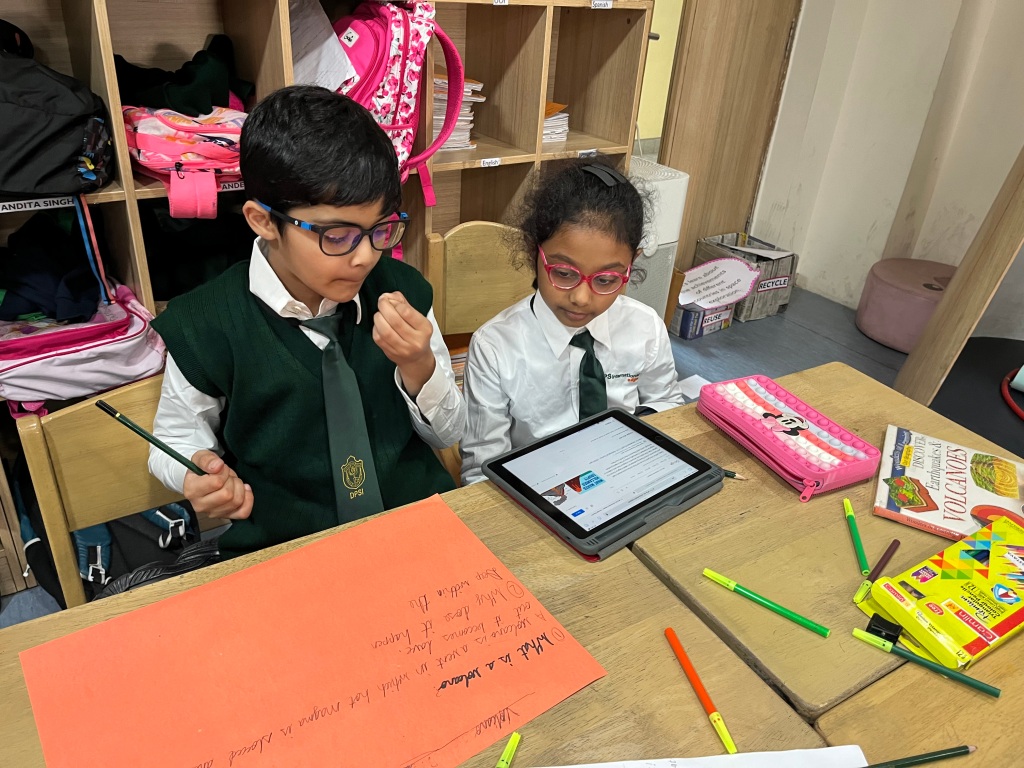







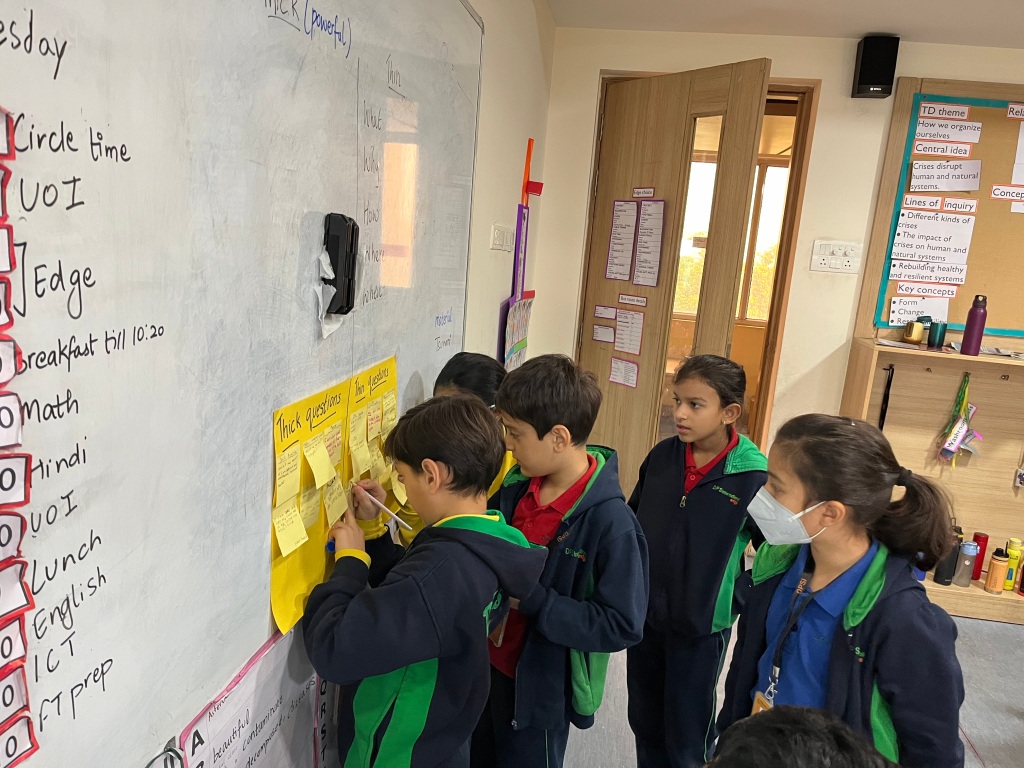
English:
To assess prior knowledge of pronouns, students read a paragraph and edited it based on their understanding of pronouns. They gained an understanding of the various types of pronouns and their usage. To reinforce this understanding, they attempted drill sheets.
Math:
Students were assessed for their prior understanding of multiplication. They created a concept map to share vocabulary related to multiplication such as product, factors, multiplicand, multiplier, and groups. The symbol used for multiplication was also explored. Students also learned and practiced different multiplication strategies using manipulatives, place value mats, and boards. The strategies included array, equal groups, repeated addition, and skip counting.


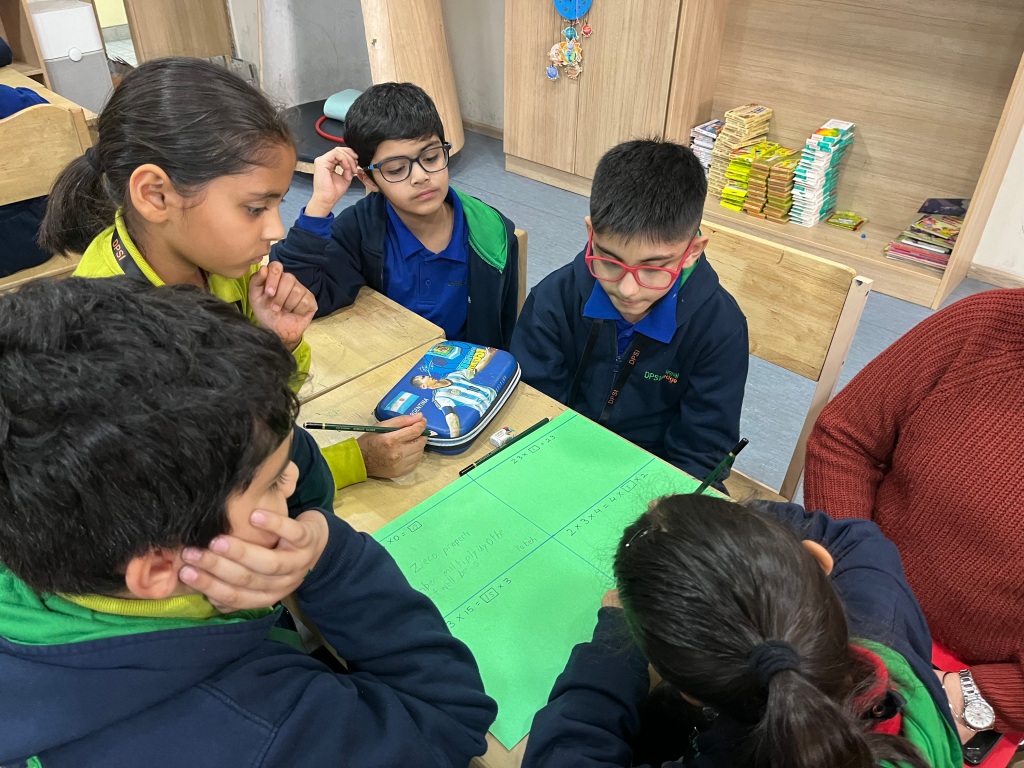

French:
Students started the week by learning different professions in French. Such as- Danseur, professeur, coiffeur. They reinforced their understanding with a Dumb Charades game. In the subsequent class, they framed sentences using the ‘etre’ verb. Such as – je suis danseur, je suis coiffeur.
Spanish:
Students learned how to denote possession by learning the first form of the verb ‘tener’ i.e., Yo tengo (I have). They applied their prior knowledge of body parts to frame short phrases. Students were also introduced to vocabulary related to fruits. They noted the same in their journals and identified their favourite fruit from the list. The vocabulary of fruits was accompanied by definite articles. It helped students understand the use of different forms of definite articles according to the gender of nouns in Spanish unlike in English which has ‘the’ as a solitary definite article.
Hindi:
Students learned the concept of विराम चिह्न, संज्ञा (व्यक्तिवाचक और जातिवाचक) and सहायक शब्दों का प्रयोग. This was followed by different exercises. By using सहायक शब्द, students were able to strengthen their vocabulary. They applied their understanding of different topics to write sentences.
Hindi – Ab initio:
During their Hindi ab initio classes, students focused on learning the ‘ए’and ‘ऐ’ matraa. They practiced the same to write words and sentences. They read a passage to develop their reading skills and emphasized the usage of the ‘ए matraa.
Art:
Students were introduced to the basics of perspective in art. They observed and discussed perspective as a drawing skill and as an individual point of view. They also learned important terms used in perspective drawing.
ICT:
Students reviewed MS PowerPoint, revisiting the fundamentals of generating, saving, and renaming presentation files. They commenced their individual PowerPoint projects, and skilfully integrated text and pictures to create engaging and informative presentations.
PHE:
In their physical education class, students acquired skills in badminton and engaged in playing dodgeball and relay races for fun and agility development. In tennis lessons, students played point matches and fitness workouts. This contributed to their overall well-being, strength, and flexibility.
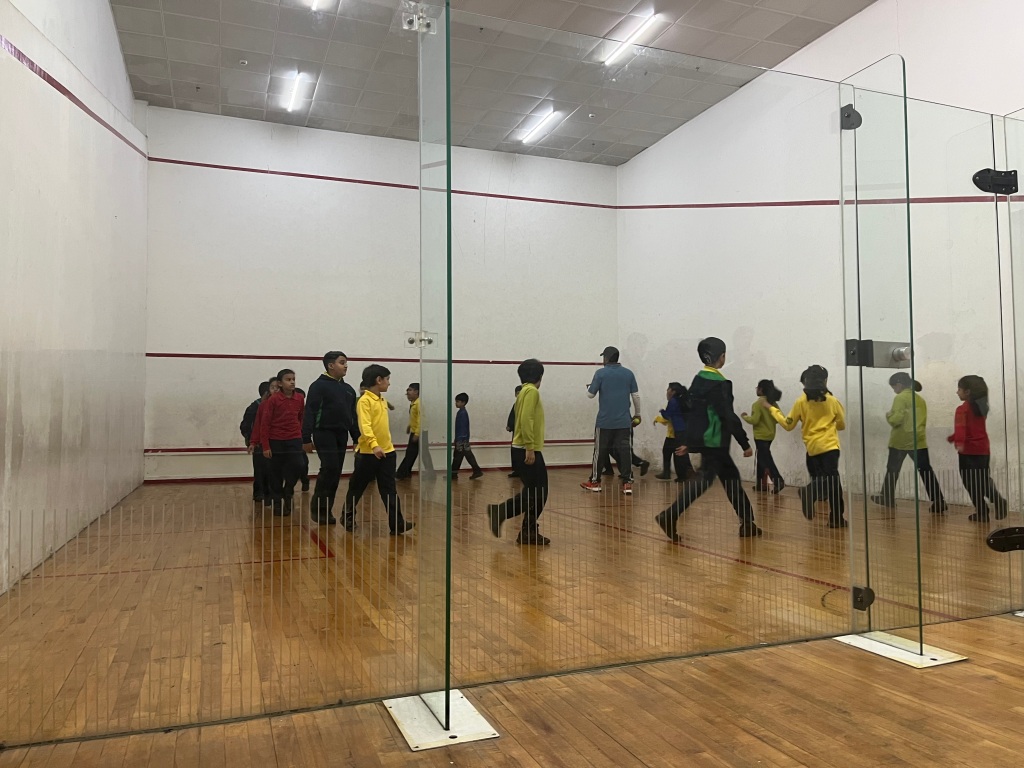
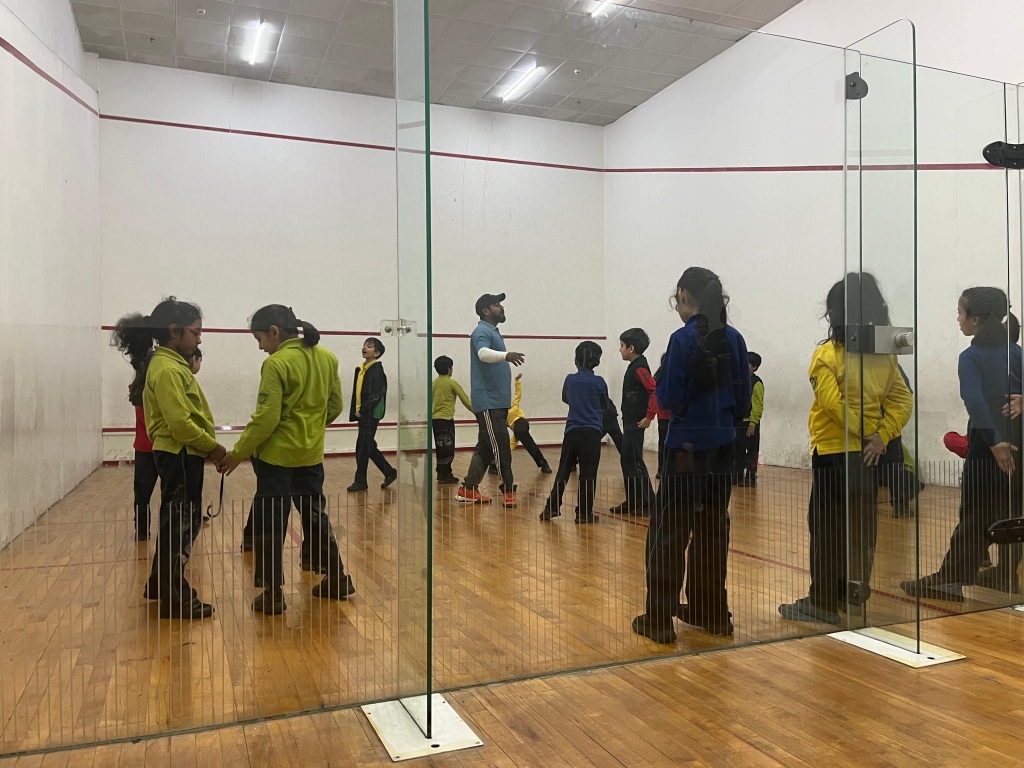
Dance:
Students worked in groups to choreograph small routines using their knowledge of coordination and isolation. They will present their pieces to their peers and receive constructive feedback based on their performance.
Music:
During music lessons, students focused on grasping the foundational elements of notation by learning the lines and spaces of the treble clef. With interactive learning, students understood the placement of notes on the treble clef. They reviewed the musical note values to boost their understanding of beats and counts. This essential aspect of music theory aided their understanding of basic staff notation.
Library:
Shri Guru Nanak, the first of the ten Sikh Gurus, is known to be a great saint. He is the founder of Sikhism. His birth anniversary celebrated as Guru Nanak Jayanti or Gurupurab globally, is marked with deep devotion and reverence. Students were acquainted with Guru Nanak Dev Ji’s principles and teachings during the library lessons. They learned about his life and spiritual journey. Students read aloud a chapter named ‘The Birth’ from the book ‘Guru Nanak Dev Ji’ and were familiarized with a few aspects of the Sikh culture. Such as Prabhat Pheri, Gurudwara visits, the Langar system, and the Nagar Kirtan. They were encouraged to embrace the path of universal brotherhood and peace, aiming to promote communal harmony.
SEL:
During their SEL lessons, students understood the essence of setting priorities as an ongoing process. With self-awareness and intentional effort, they recognized the significance of prioritizing which is to focus on what needs to be achieved and accomplished first.
The ‘Jar of Life’ activity was centred around recognizing the ‘big rocks’ – the significant elements that provide meaning to our lives. Students understood the importance of placing their chosen ‘big rocks’ into the jar, followed by introducing smaller pebbles and sand representing less critical elements. These served as a reminder that while valuable, they should not overshadow their priorities. Following this activity, a discussion on developing and implementing strategies like identifying the big rocks, realizing priorities, managing distractions, setting goals, and making action plans, enabled students to understand the significance of establishing priorities to lead a balanced lifestyle.
Grade 3 blog
November 5 – November 17, 2023
UOI
The unit on waste and waste management culminated with a knowledge-based quiz.
Students were tuned into the new unit with hands on experience of scientific experiments based on a natural crises.
Transdisciplinary theme: How we organize ourselves
Central idea: Crises disrupt human and natural systems.
Lines of inquiry and key concepts:
- Different kinds of crisis (Form)
- The impact of crises on human and natural systems (Change)
- Rebuilding healthy and resilient systems (Responsibility)
Students arrived at the TD theme of the new unit, “How we organize ourselves,” by analyzing various images to understand how different systems work for us. They understood the essence of the new unit with a game ‘Floor is Lava’ to arrive at the word -crisis.





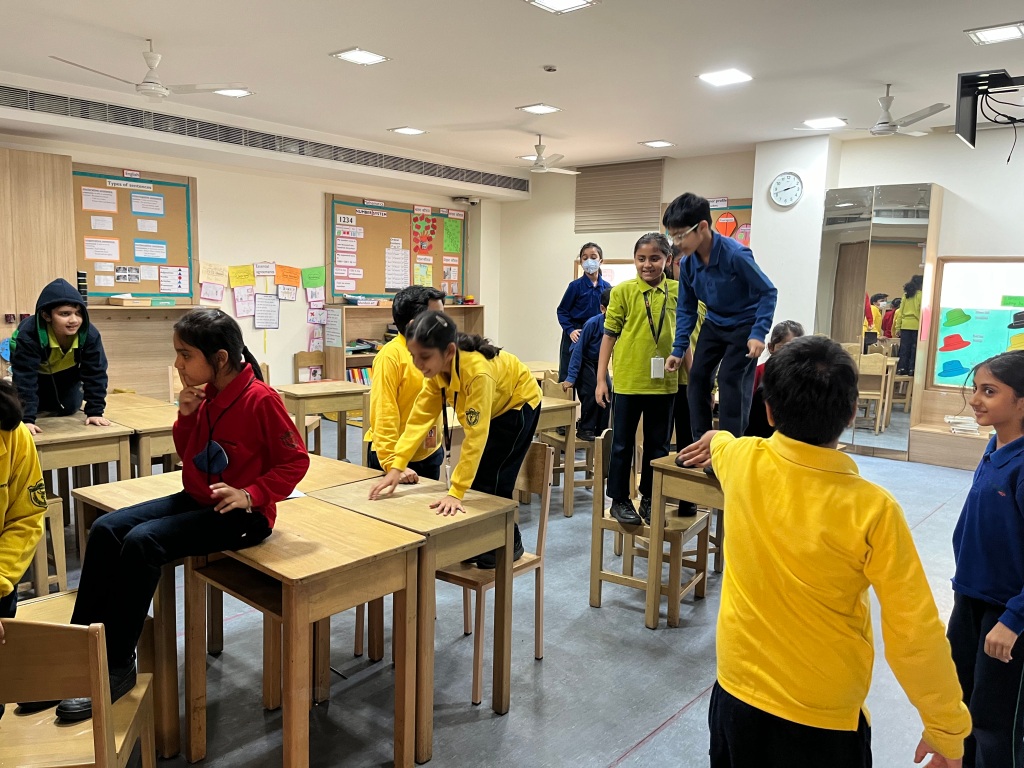



English
In the literary realm, students took turns reading the novel ‘Adventures of Huckleberry Finn’ and identified regular,irregular verbs and adjectives Subsequently, they constructed sentences with irregular verbs. To enhance their comprehension skills, students created comprehension questions based on the text and exchanged these questions with their peers to answer them in their journals. Spell Bee was also attempted to strengthen vocabulary knowledge.
Math
Math sessions focused on recapitulating the concepts of addition and subtraction. Students practiced the inverse relationship between addition and subtraction. They were introduced to the CUBES strategy to solve subtraction word problems. They identified the keywords to practice word problems in their journal.
French
Students were familiarised with the names of animals in French. They revised adjectives and names of colors. They also practiced the song “Trois petits pas” for their Unit Of Inquiry.
Spanish
Students were introduced to vocabulary related to different body parts with a poem. Pictorial clues were used to reinforce the same. Students learned to communicate time in Spanish and understood the basic sentence structure for singular or plural numbers. They reinforced their understanding by reading the time on a clock in Spanish.
Hindi
During Hindi classes, students revisited helping verbs. They also attempted the spell bee task.
Hindi ab-initio
Students enhanced their listening skills and spelling comprehension. They reviewed all the matraas covered in previous classes. They sharpened their listening skills with the story ‘बातूनी कछुआ’ and demonstrated their understanding by answering relevant questions. They organized visuals from the story in chronological order and retold it in their own words.
Art
Students drew a point perspective landscape as a prior knowledge assessment. They also created rangoli designs in vibrant colors on the occasion of Diwali.
ICT
Students honed their coding skills with practical exercises on the code.org website, focusing on essential blocks such as ‘move forward,’ ‘turn right and left,’ and repeating blocks. These coding elements were strategically employed to solve puzzles thereby providing an engaging and enjoyable experience for students.
PHE
In their swimming class, the students honed their backstroke and freestyle skills. They learned a variety of fundamental skills like standing floating in deep and bubbling while swimming. These skills provided a well-rounded foundation for their swimming skill development. In their basketball class, students acquired skills by playing dodgeball matches for fun and enhanced agility. Fitness workouts improved their overall well-being, emphasizing endurance, strength, and flexibility.
Dance
Students learned swift coordinated movements of different body parts such as arms coupled with leg movements, and head coupled with hand movements according to the musicality. They were also introduced to the concept of symmetrical and asymmetrical movement in dance.
Music
Students explored percussive rhythms using waste materials, fostering a unique connection between music and environmental consciousness. By repurposing non-musical objects, the practice not only enriched musical skills but also instilled a sense of responsibility towards sustainable practices. They also rehearsed the song “The Earth is my home” promoting environmental consciousness, to convey a message of hope and urgent awareness for the environment. With this fusion of musical efforts and engagements, students learned to harmonize their musical talents with a commitment to a greener future.
Library
Lights have been essential in many festivals, symbolizing the dispelling of darkness. They hold different meanings in various cultures, leading to the celebration of festivals of lights worldwide. In library lessons, students explored diverse light festivals across the globe, including Bala Chaturdashi in Nepal, Loy Krathong in Thailand, the Lantern Festival in China, Hanukkah in Israel, Nebuta Matsuri in Japan, and Lyon in France. Many of these national and international festivals are linked to different moon phases.
The Indian festival of lights, Diwali is celebrated on a new moon night.. Candles and crackers are considered integral to this festival. However, it was emphasized that the crackers used during Diwali pollute the air and pose a threat to human health while also carrying the risk of burn injuries.
The session concluded with the exchange of Diwali wishes.
SEL
SEL lessons focused on understanding and cultivating empathetic behaviour amongst students. They listened to a story, ‘Stand in My Shoes’ while weaving a narrative that highlighted the importance of understanding others’ perspectives. Students also discussed ways to display empathetic behaviour and its significance in fostering connections and understanding in relationships. They shared their experiences and brainstormed how to cultivate empathetic behaviour in real-life situations. They explored empathy with episodes from the Ramayana to illustrate its significance in making profound human connections. Students later concluded their understanding by a reflection task ‘Thinking it or Saying it’. It presented various scenarios and allowed them to introspect the impact of their words and actions.


October 16 – November 3, 2023
UOI
Students tuned into the third line of inquiry with a prior knowledge assessment on waste management. They gained an understanding of sustainable practices by researching and exploring the 7Rs, showcasing their knowledge using informative posters.
Students learned about various waste management methods and assessed them using De Bono’s hats.
To deepen their inquiry about sustainable practices, students of grade 3 took up a weeklong initiative to collect E-waste through a drive. Students in large numbers turned up to support the initiative.
As a culminating event marking the end of the weeklong E-waste collection drive, students went on a field trip to the waste recycling facility named Samadhaan Hub (in collaboration with the NGO – I am Gurgaon). A total of 14 kilograms of E-waste collected at DPSI, was deposited at the hub which would be sent for recycling. Students later reflected on the field trip using the 3W and 1H thinking routine.
They attended another guest speaker session, this time conducted by grade 5 students who presented a prototype of a vending machine as an innovative and sustainable solution to address a pertinent problem related to the Sustainable Development Goals (SDG). Students demonstrated their understanding of the third line of inquiry by attempting a formative assessment.












English
Students enhanced their communication and self management skills during practice session. Students attempted various drill sheets to recap the previous grammar concepts.
Math
Students learned about the properties of subtraction and their application. They honed their subtraction skills by practising the solution to subtraction equations with and without regrouping. Furthermore, they learned how to create fact families which helped them to understand the inverse relationship between subtraction and addition. To enhance mental math abilities, students were introduced to subtraction using the compensation method.
French
Students started the class with a fun game to recapitulate their understanding of the language. They learned various French adjectives, their meanings, and how to use them with “être” verbs for self-description, such as “Je suis belle” (I am beautiful) and “Je suis intelligent” (I am intelligent).
They practiced the song “Trois petits pas” for their UOI presentation, relating it to the theme of “Waste management.”
Spanish
Reinforcement of past concepts was done wherein students revised vocabulary pertaining to numbers, days of the week, and colours with emphasis on spelling and pronunciation. They reviewed the correct usage of “Yo soy” and “Yo estoy” when describing personal traits or emotions. In preparation for the UOI presentation, students enthusiastically practised the Spanish song.
Hindi
Students revisited the topic of adjectives. They actively honed their communication skills by engaging in practice sessions for their upcoming UOI presentation.
Hindi ab-initio
During their Hindi ab-initio classes, students dedicated their time to review all the matraa covered in the class. They actively honed their speaking abilities by engaging in regular practice sessions for their upcoming UOI presentation.
ART
After the introduction to newspaper craft, students learned how to create sticks by rolling newspapers. Students used these sticks to create different objects like bowls, coasters, mats, etc. This improved their skills in sculpting used paper.
ICT
Students worked on Minecraft which showcased their ingenuity and problem-solving skills. With a focus on environmental awareness, they collaborated to design an innovative waste disposal system within the virtual realm of Minecraft. Their project demonstrated technical proficiency and highlighted their deep understanding of sustainable practices. Using various blocks, they constructed a virtual world where waste disposal became a seamless and eco-friendly process. This hands-on experience not only honed their teamwork abilities but also instilled in them a sense of responsibility towards the environment, making the activity both educational and engaging.
PHE
In physical education, students acquired basketball skills, enjoyed dodgeball matches, and improved their fitness through workouts, focus on endurance building, strength, and flexibility training.
Dance
Students demonstrated movement isolation in dance by isolating specific body parts while keeping others still. They also learned the importance of waste management and practiced their UOI presentation dance routines.
Music
Students were taught the importance of waste management and its relation to music to promote environmental awareness and creativity. They learned how to repurpose waste materials to create model musical instruments, turning trash into treasure. This hands-on activity not only taught them resourcefulness but also instilled a sense of responsibility toward waste disposal. Through their creations, students experimented with percussive music and created unique rhythms and melodies, fostering their musical talents and creativity while emphasizing recycling and sustainability.
Library
“Diwali is a symbol of hope for humankind. May it bring universal compassion, an inner joy of peace, love, and the awareness of unity to all.” Happy Diwali!
During their lessons, students learned about festivals of lights celebrated across various countries like Loy Krathong in Thailand, the Chinese Lantern Festival in China, Hanukkah in Israel, Nebuta Matsuri in Japan, and Lyon in France. The location of countries was pointed on a world map. Religious beliefs and the significance of these celebrations were also briefly explained.
They listened to the story “Hurray for Diwali” and joined Gittoo and his family, who were gearing up for the festival of lights. They were able to form personal connections with the story and exchange ideas about how they would celebrate the festival.
New updates from grade 3B………..
3rd October – 15th October
UOI
Students worked in pairs to read and analyse newspaper articles related to the impact of waste on the environment. They used the visible thinking routine “see-think-wonder” to share their thoughts and wonderings. They delved into the problem of e-waste and its adverse effects on the environment. They used various resources, such as iPads, books, fact sheets, and PowerPoint presentations, to inquire how waste contributes to air pollution. They also investigated the potential environmental impacts of air pollution. Students shared their understanding of different types of waste using the SEE I (State, Elaborate, Example, Illustrate) strategy.


English
Students explored the connection between tenses and verbs and understood how verbs provide insight into the timing of actions. They deepened their understanding of regular and irregular verbs and learned that regular verbs typically end with -d and -ed in the past tense, while irregular verbs change their form. They attempted drill sheets to reinforce this knowledge. Students also read chapter 6 of the novel study “Adventures of Huckleberry Finn” to enrich their language skills. They identified helping and auxiliary verbs and used them to create meaningful sentences.
Math
In math lessons, students shared their prior knowledge of bar graphs using the visible thinking routine- See, Think, and Wonder. To gain a comprehensive understanding of the components of a bar graph and its interpretation, students explored various bar graphs. They were encouraged to share their prior knowledge of subtraction with concept maps or visual representations. They honed their skills in adding 3 to 4-digit numbers.
Students were assessed for their written communication skills related to greetings. They also learned single-step instruction words showcasing their listening and speaking skills, such as EX-Ecrivez! (Write), Répétez! (Repeat)Chantez! (Sing). In preparation for their UOI presentation, they practiced singing the song “Trois petits pas.” They understood the meaning of the lyrics and were guided to improve their pronunciation.
Spanish
Students were introduced to the lyrics of a Spanish song for their upcoming UOI presentation. They also learned about the first form of the verb “ser” Yo soy, which is used to describe personal traits. They were familiarised with the first form of the verb “estar” Yo Estoy to express their emotions on a chart.
Hindi
Students were introduced to ‘पर्यायवाची शब्द’. They read a poem ‘बढ़े चलो’ and wrote synonyms for a few words from the poem. They enhanced their communication skills by listening to a story and attemped oral comprehension. They also attempted to segregate words into ‘व्यक्तिवाचक संज्ञा और जातिवाचक संज्ञा’.
Hindi ab-initio
During their Hindi ab initio classes, students explored ए (e) matraa. They reinforced their understanding by reading texts with ए matra words and wrote the same in their journals. Students also identified various fruits and wrote their names.
ART
Students completed their Kalamkari work and reflected on their experience of doing Kalamkari art.
ICT
Students shared their opinions and reflections regarding the causes and consequences of e-waste, as well as the scientific methods for managing e-waste, using Padlet. Additionally, students were introduced to Minecraft, where they acquired skills, such as walking, jumping, turning, sprinting, breaking, and placing blocks, sneaking, and mastering mouse and keyboard control.
PHE
Students in physical education class were engaged in a series of physical activities, including yoga sessions, gymnastics, and exciting games. These activities not only promoted physical fitness but also fostered teamwork and a sense of accomplishment. They demonstrated incredible flexibility and balance as they practiced walking and balancing on one leg on the balance beam and front roll in gymnastics. Students learned grip and stance in table tennis. In swimming, students are continuing to hone their fundamental skills like bubbling and floating.

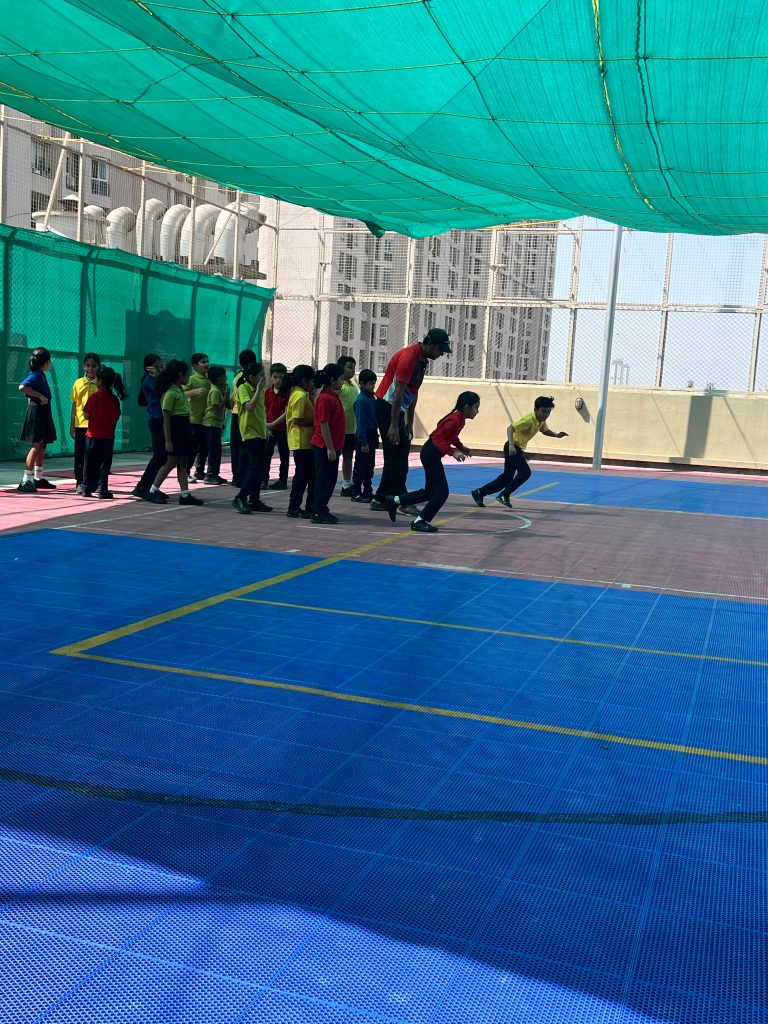
Dance
Students practiced swift coordinated movements of different body parts such as arms coupled with leg movements, and head coupled with hand movements according to the musicality. They also learned new dance routines as they began preparing for their unit presentation.
Music
Students practiced rhythm exercises with a clapping rhythm. They were divided into groups and each group participated in a group rhythmic challenge. They learned the term ‘Quarter Rest’ and its function in music. They demonstrated different rhythmic patterns on the Congo. They showcased their dynamic skills as they played on the percussive instruments.
Library
The school book fair is an exciting time of year for students. They explored and discovered different types of books, new authors, and genres, and broadened their horizons. They were able to find books in different genres, from fiction and fantasy to science fiction and non-fiction. They found books about history, science, math, and even books about the future. There were also books about art, music, and the world around us. Students also enjoyed the atmosphere of the book fair, as it provided an opportunity to connect with other book lovers.
New updates from grade 3B………..
UOI
September 18 – September 27, 2023
Transdisciplinary theme: Sharing the planet
Central idea: Human activities create waste which can affect our environment.
Lines of inquiry and key concepts:
● Types of waste (form)
● Effects of waste on our environment (causation)
● Waste management (waste management)
Students tuned into the new unit with the conceptual lens ‘Ecological impact’ under the transdisciplinary theme ‘Sharing the planet’. They watched an animated short film, ‘Man’ by Steve Cutts, and reflected on the same using a graphic organizer ‘See it! Feel it! Ask it! Show it!’ A newspaper headline that summarized and captured a significant key aspect from the audio-visual was created by students.
Students were tuned into the unit with a gallery walk where they observed pictures related to waste and pollution. They noted down keywords related to the pictures and used the placemat strategy to write their reflections. Students used the visual–word–association strategy to share their understanding of the conceptual lens -Ecological impact.
As part of their prior knowledge assessment, students segregated waste into different categories as per their understanding. They worked in groups to research and create a presentation on different types of waste. They explored the risks involved in the disposal of e-waste and industrial waste into landfills. Students understood the difference between biodegradable and non-biodegradable waste and shared how they dispose of waste in their homes. They gained an understanding of hazardous waste and the need to discard it properly.



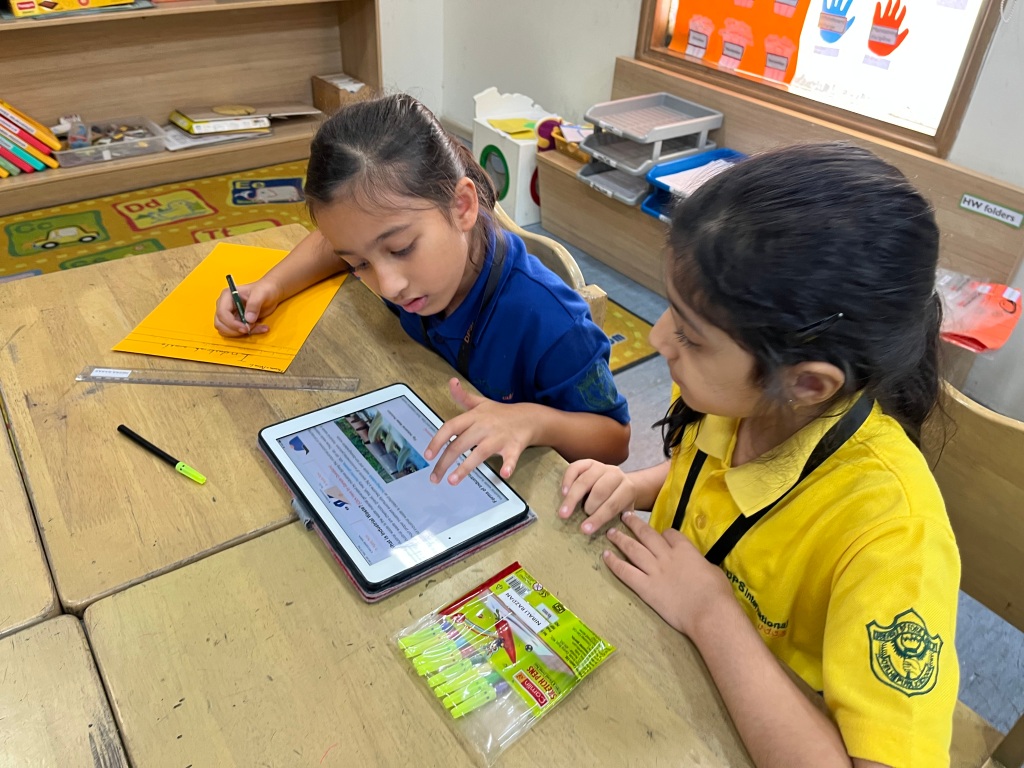

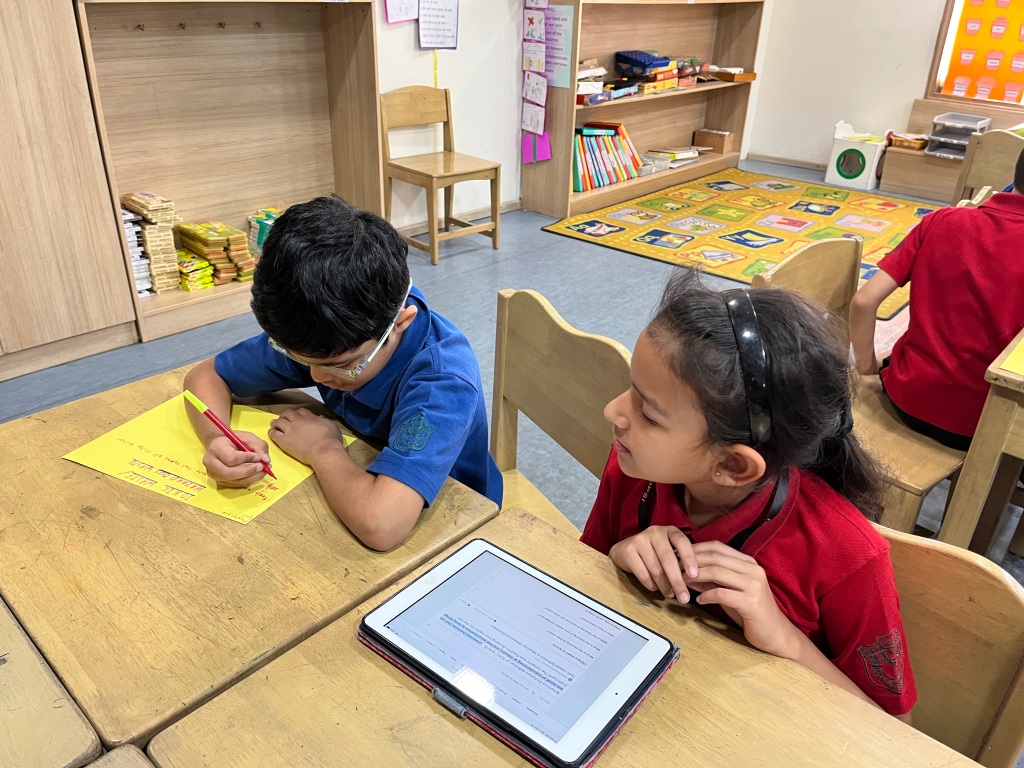
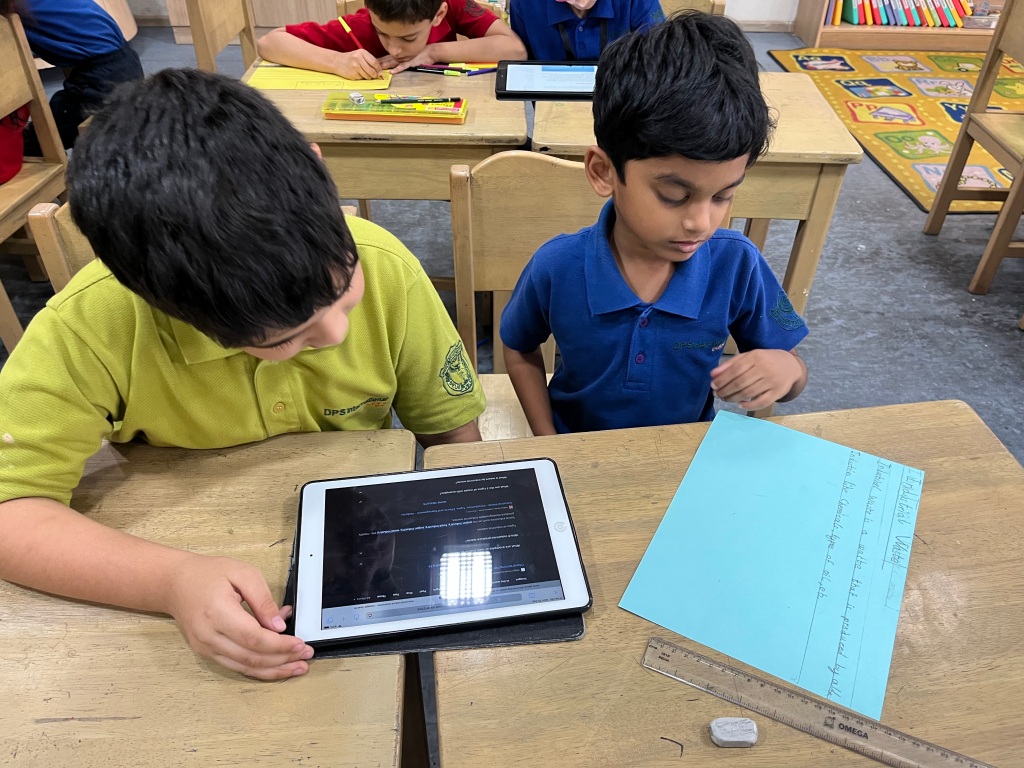


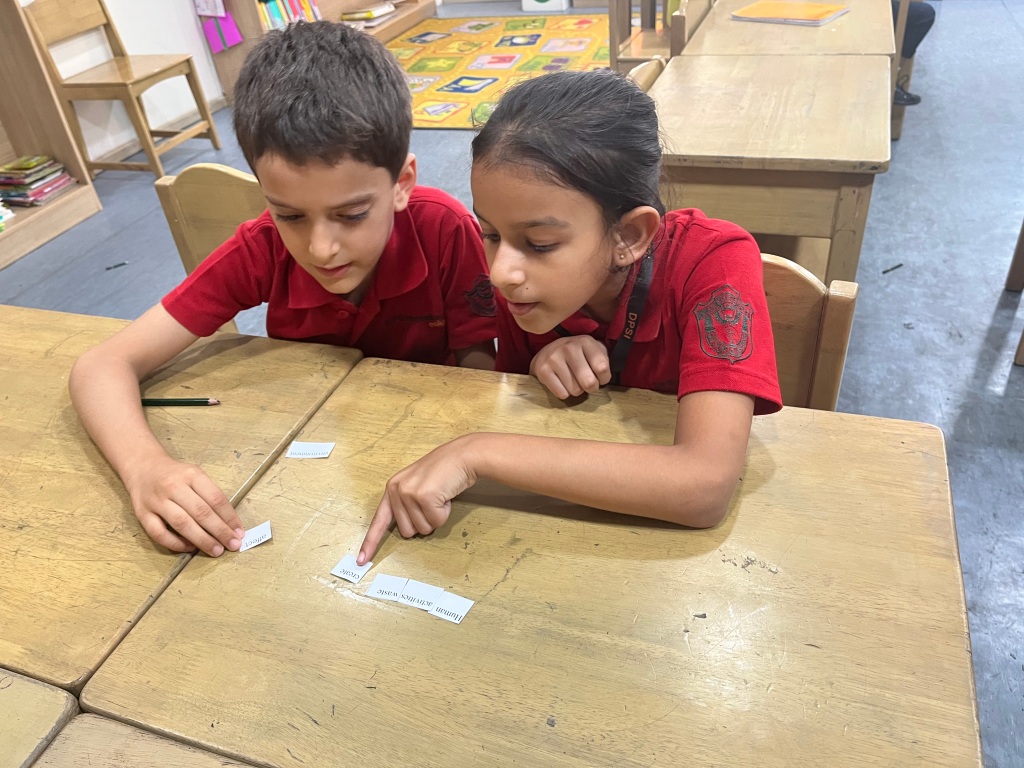






English
Students were engaged in reading and comprehending the novel study “Adventures of Huckleberry Finn”. They enriched their vocabulary by learning new words from the novel. Students reflected on their understanding of the chapters using different visual thinking routines. They strengthened their understanding of collective nouns and abstract nouns with various drill sheets. Students were also introduced to the possessive case of nouns.



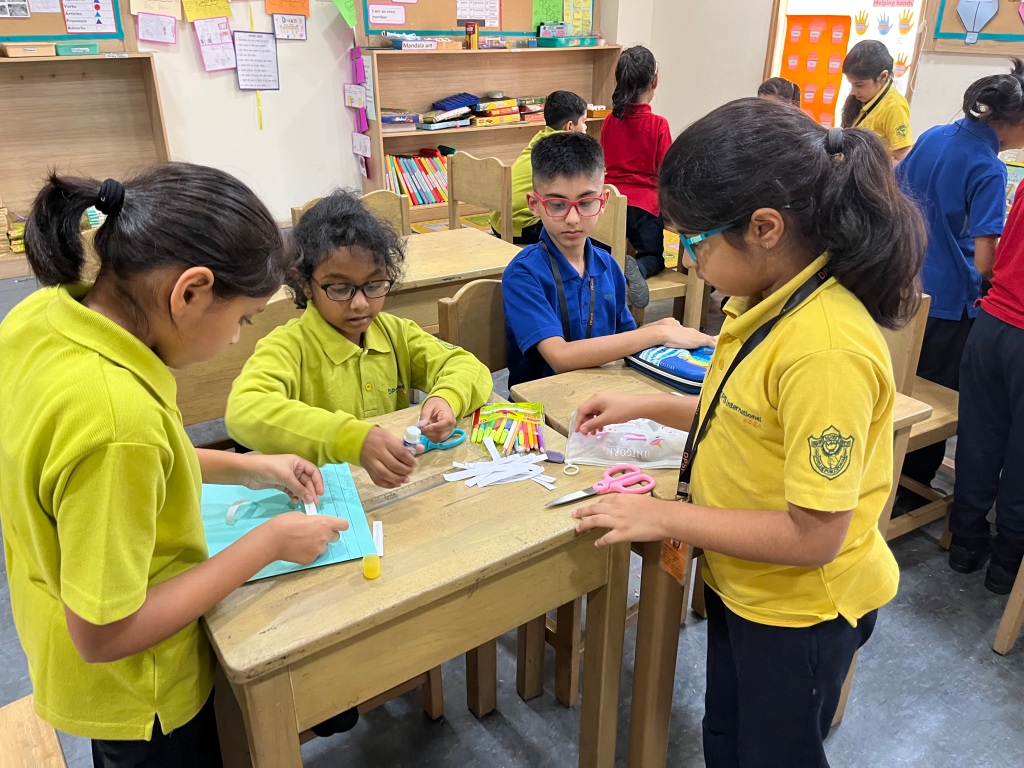
Math
Math sessions focused on recapitulating the concept of addition. Students understood the inverse relationship between addition and subtraction. They practiced solving addition word problems using the CUBES strategy. They enhanced their critical thinking and analytical skills by finding the missing addends and attempting magic squares, number grids, and riddles. Students attempted a formative assessment to showcase their understanding of addition.






Hindi
Students learned the concept of ‘तुकांत शब्द’. They read and analyzed poems to enhance their communication and thinking skills. They applied their understanding of ‘तुकांत शब्द’ to write short poems on chosen topics They also attempted a spell bee activity to strengthen their vocabulary knowledge.
Hindi ab initio
During their Hindi ab initio classes, students learned ई and उ matraa. They practiced the same by writing words with the same sound and framed meaningful sentences.
French
Students learned vocabulary words related to details such as their name, age, nationality, the city where they reside, and languages spoken. They were also familiarised with some French accents and their pronunciation. like accent aigu, accent, grave, cedilla.
Spanish
Students learned how to tell and write seasons in Spanish. They were also introduced to number names from 21-31. They applied their prior knowledge of numbers from 1 to 20 to share their respective birth dates with the rest of the class and also participated in a game to identify the number of days in a particular month. Students were also engaged in an inquiry about some well-known cities in Spain such as Madrid, and Barcelona. They used the KWHL chart to share their findings.
PHE
Students were engaged in a series of physical activities, including yoga sessions, gymnastics, and exciting games. These activities not only promoted physical fitness but also fostered teamwork and a sense of accomplishment. They demonstrated incredible flexibility and balance as they practiced walking and balancing on one leg on the balance beam. In the swimming lessons, students practiced freestyle swimming and kicking for 25 meters. During tennis class, students participated in point matches and displayed forehand hits.

Art
Students learned about different ways of using the brush while doing traditional art forms and coloured their compositions. They worked in teams demonstrating their social and collaborative skills. Students were encouraged to do free-expression drawing and doodling to relax their minds.
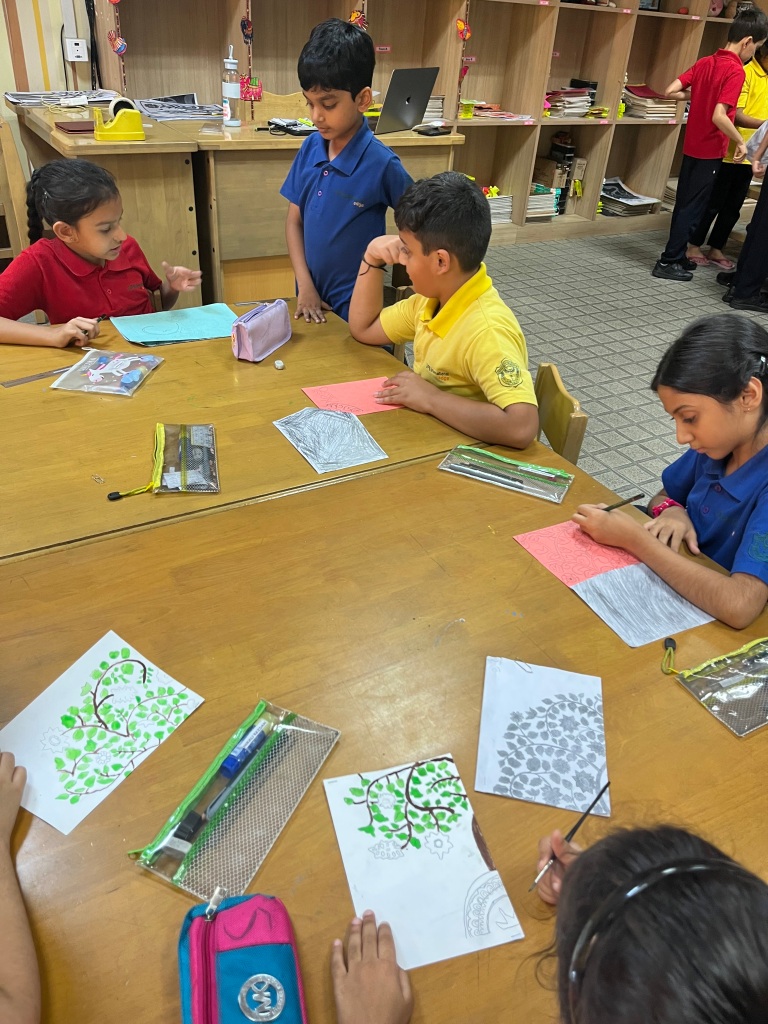

Dance
In dance lessons, students understood swift coordinated movements of different body parts such as arms coupled with leg movements, and head coupled with hand movements according to the musicality.
Music
Students have learned how to draw the Treble clef and Bass clef accurately on the music staff, which are important musical symbols to understand Western music notation. They have learned the note values and respond to the Whole note, Half note, and Quarter note beat by clapping and playing with the shaker and on the Congo, which is key to understanding the rhythm of the music.


SEL
To understand the concept of responsibility, students listened to a story on learning to shoulder responsibility. They identified different types of goals and as a reflection, listed the ones they are currently pursuing and wished to accomplish. They undertook this reflection activity using ‘I can, and I can’t yet’ statements. Students recognized the significance of taking initiative as a means to explore and enhance leadership skills to perform age-appropriate tasks and take small responsibilities.
Library
“There is no ‘way to peace, there is only peace.” -Mahatma Gandhi
Achieving world peace requires efforts from every individual. It calls for tolerance, a caring attitude, and empathy towards others, among many other things. Developing citizens who will contribute to creating a better, more peaceful world lies at the heart of an IB education. Students recognized that they have a responsibility to make a change in the world and apply the IB Learner Profiles to make a difference. On the occasion of the International Day of Peace, students came together to engage in meaningful discussions about the essence of peace. They were guided with opening statements: Peace looks like… Peace sounds like… Peace feels like…” to explore their thoughts and feelings about this elusive yet essential concept.
To them, peace was not just the absence of conflict; it was a vibrant tapestry of harmonious coexistence and cooperation.
ICT
Students understood how a strong password helps to safeguard personal privacy. They also learned to create a secure and easy-to-remember password through a hands-on activity. Students learned about the environmental and health repercussions of electronic waste (e-waste) and were provided with insights into its proper handling. This information was conveyed with audio-visual presentations and various online reports.
September 4 – September 15, 2023
UOI
Students researched about the discovery of water on Mars and the surface of Pluto. They employed De Bono’s thinking hats to analyse the positive and negative impacts of various inventions resulting from space exploration. To showcase their understanding of discoveries due to space exploration, students attempted a formative assessment.
As an extension of their learning, Grade 3 students went for a field trip to the Nehru Planetarium. Students thoroughly enjoyed exploring the exhibits and gaining information about Indian astronomy, planetary movements, telescopes, Indian astronauts, the Big Bang theory, and more. They were able to make meaningful and relevant connections with the learning engagements during the unit. A highlight of the trip was the sky theatre, where they viewed the show ‘‘Biography of the Universe.’’ which provided meaningful insight into galaxies, the birth and death of stars, planets in the solar system, and other celestial bodies.
English
Students were introduced to paragraph writing using the hamburger strategy. As a pre-writing activity, they examined exemplars and transition words. They were agentic learners as they created a checklist for paragraph writing and used it to write a paragraph on a chosen topic. They were also engaged in reading, comprehension, and paragraph writing tasks based on the novel study “Adventures of Huckleberry Finn”. Students understood the importance of listening skills with a listening comprehension activity on astronaut training. They also participated in educational games such as Noun Relay Race, Collective Noun Game, and Collective Noun Bingo to recap their understanding of nouns. Abstract nouns were introduced followed by their application in sentence formation. Students also displayed their vocabulary knowledge with an interesting spell bee task.
Math
As students progressed in their understanding of addition, they practiced adding 3 – 4 digit numbers with and without regrouping. The place value mat was used to reinforce addition with carryover. Students used the expanded form strategy to add numbers horizontally. Building on this knowledge, they were able to understand the concept of doubling numbers as an addition strategy. Additionally, a mental math strategy – compensation strategy was introduced to help students calculate faster and more accurately.
Hindi
Students were introduced to ‘तुकांत शब्द’ through the poem ‘अक्कड़-बक्कड़ बंबे बो’. They enhanced their reading skills by reading the poem and sorting the rhyming words. They also attempted to write couplets. They listened to a story and attempted oral comprehension questions.
Hindi ab initio
During their Hindi ab initio classes, students learned ई matraa and practiced writing words with that sound. They also read sentences with ई matraa to enhance their reading skills. Their speaking skills were enriched through an engaging activity called ‘बस एक पल’, where students discussed their favorite fruit.
French
The week began with a revision of counting and salutations in French. Students continued to learn the names of the months of the year through various festivals in France and India. This allowed them to delve into the different cultural aspects of the two countries. Students also filled out a form in French with their personal information (Nom, Prenom, Cours, école, age, etc.).
Spanish
Students revised the number names in Spanish from 10 to 20 and recorded them in their journals. They watched a song on the months of the year in Spanish and shared their month of birth with their classmates. They reinforced their understanding by arranging cards with different months in sequential order. Different audio-visual resources were used by students to learn about the seasons and days of the week.
PHE
Students continued with the unit on gymnastics where they were familiarised with the body stance to walk and balance on balance beam. They learned the breathing techniques while performing asanas as part of their yoga lessons. In the swimming lessons, students practiced bubbling, floating, and freestyle swimming in the lane. During the tennis class, students practiced forehand hits to the opponent’s court and played fun games to improve their reflexes.
Art
After learning the different patterns of Kalamkari art, students drew a composition in Kalamkari art within their groups. Students learned how to trace an image onto a sheet. This technique allowed students to understand shapes, proportions, and the intricacies of an image without the pressure of freehand drawing. It served as a foundation for developing essential skills. Further, students coloured the composition and gave an outline to the pattern.
Dance
In dance lessons, students understood swift coordinated movements of different body parts such as arms coupled with leg movements, and head coupled with hand movements according to the musicality.
Music
Students learned to draw the music staff. They also learned to draw a treble clef in a music staff the correct way. They were engaged in learning the song “Lean on Me” and also practiced singing the song using solfege, which is a good exercise to perfect the pitch skill.
SEL
Self-awareness is the cornerstone of social-emotional learning. Students undertook an activity to recognize their emotions and understand the impact on their behavior. They further explored the concept of mindful listening, and its benefits and explored ways to cultivate the same in their daily lives. They understood mindful listening as an essential component of effective leadership skills. Students culminated the activity by reflecting on some thought-provoking questions and engaged in meaningful discussions with their peers.
Library
“One book, one pen, one child, and one teacher can change the world.” -Malala Yousafzai
With the belief that there is nothing as powerful as education, the world celebrates Literacy Day on 8th September every year. Literacy is crucial for one’s social and personal development. Students were made aware of the importance of literacy to individuals, society, and communities.
Students also participated in a book bingo activity, which was a fun way to inspire them to read a variety of books and cultivate a love of reading. Each square featured a book or activity that led students to explore the library’s resources and exposed them to genres of fiction they might not have otherwise discovered. Through this engagement, they acted as library detectives and developed their literacy skills.
ICT
Students grasped the importance of a strong password to ensure the protection of their private data. They acquired the skill of crafting a secure password through a practical exercise. Additionally, students were presented with ‘if…then’ scenarios to illustrate the potential consequences of password theft.
Celebrating Teacher’s Day: Honouring the Guardians of Knowledge
Students of PYP marked teacher’s day with heart-warming poems, songs, and dances. They organized fun games and engagements to express gratitude and appreciation for the teachers who guided them on their educational journey.
Janmashtami Celebration:
Students of PYP marked the Indian festival ‘Janmashtami’. They enjoyed story narration to gain an insight into the leadership qualities of Lord Krishna. They also gained valuable lessons from the life of Lord Krishna.
National Nutrition week
Grade 3 students embarked upon a one-week journey to understand the importance of the world’s land and water resources that support food and agriculture using an audio-visual presentation. Students rated the food they ate in school to share their preferences. They also revisited the dining etiquette and understood the nuances of laying a table.

